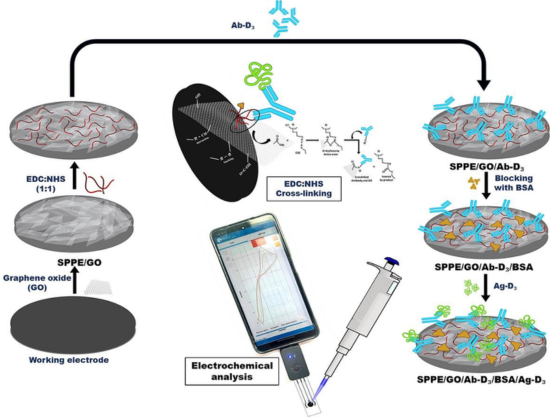+91-512-259-7629
+91-512-259-7629
Highlighted are some of the recent publications that have emerged from our department, showcasing our commitment to advancing user-centric research and design. These publications represent just a glimpse of the impactful work happening in the ChE department.
Abstract:
Hypothesis
When a liquid is inserted inside a microfluidic channel, embedded within a soft elastomeric layer, e.g. poly(dimethylsiloxane) (PDMS), the thin wall of the channel deforms, due to change in solid–liquid interfacial energy. This phenomenon is known as Elastocapillary effect. The evolution of a new species at this interface too alters the interfacial energy and consequently the extent of deformation. Hence, it should be possible to monitor dynamics of physical and chemical events occurring near to the solid–liquid interface by measuring this deformation by a suitable method, e.g., optical profilometer.
Experiments
Aqueous solution of a metal salt inserted into these channels reacts with Silicon-hydride present in PDMS, yielding metallic nanoparticles at the channel surface. The kinetics of this reaction was captured in real time, by measuring the wall deformation. Similarly, physical adsorption of a protein: Bovine Serum Albumin, on PDMS surface too was monitored.
Finding
The rate of change in deformation can be related to rate of these processes to extract the respective reaction rate constant. These results show that Elastocapillary effect can be a viable analytical tool for in-situ monitoring of many physical and chemical processes for which, the reaction site is inaccessible to conventional analytical methods.
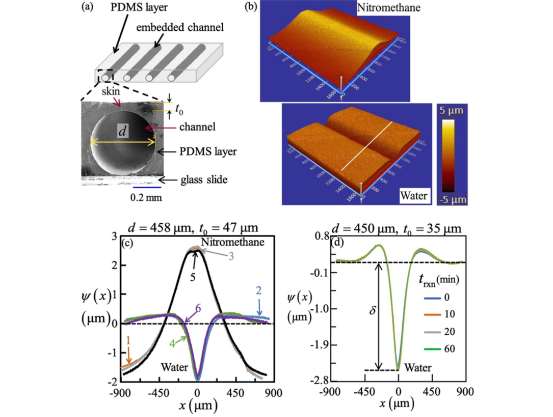
Abstract: A compact single-unit process is developed for continuous cumene manufacture via the alkylation of benzene with propylene. The design combines reactive distillation (RD) and dividing-wall separation in a single column. In terms of the TAC, it is significantly cheaper (42%) than the conventional “reaction followed by separation process” and only slightly more expensive than the RD process. The controllability of the developed compact design is confirmed via rigorous dynamic simulations that demonstrate effective process operation for large production rate and feed composition changes using a simple decentralized temperature inferential control system. The developed compact design is especially suitable for capacity expansion in space-constrained cumene manufacturing facilities.
Read More ...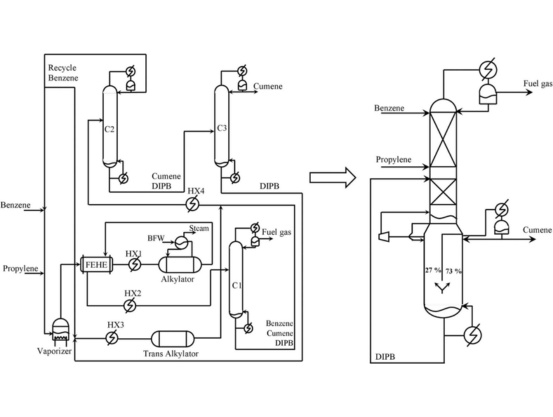
Abstract: A novel anthraquinone (AQ) integrated and S-scheme-based NiTiO3-gC3N4 (NT-gCN) photocatalytic system is synthesized with an improved electron transfer rate for hydrogen production. Materials characterization using spectroscopic techniques reveal the intimate heterojunction interface between NT and gCN as well as integration of AQ with the binary composite. The synthesized AQ-NT-gCN photocatalyst exhibits a significantly enhanced H2 evolution rate (576 μmol g−1 h−1), which is ∼22 and 33% higher than that of NT-gCN and gCN, respectively, attributed to the spatial separation of charge carriers expedited by AQ. The radical trapping test data provide evidence for the S-scheme charge transfer mechanism in AQ-NT-gCN. The present study opens a new avenue for developing an S-scheme heterojunction by integrating binary composite with an organic molecule to improve the solar to energy conversion efficiency.
Read More ...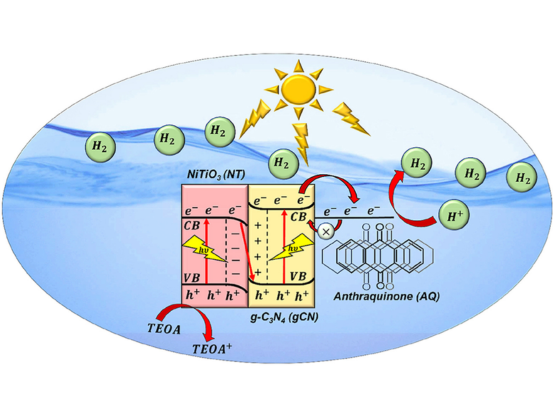
Abstract: A unique conical-shaped single-chamber (SC) microbial fuel cell (MFC) set-up was used to demonstrate the feasibility of continuous mode operation with recycling for the enhanced degradation of phenolic compounds in wastewater. Here, 1,2-propanediol/propylene glycol (1-2-PD, a phenolic compound) was used as the model phenolic compound, which is commonly found in pharmaceutical and cosmetic industrial effluents. Different flow rates (Q = 1, 3, and 5 cc min−1) and recycling ratios (RQ = 0.5, 1, 1.5 cc min−1) were used to study the effect of recycling on wastewater treatment in the continuous mode. The effects of the 1-2-PD concentration (1000, 5000, and 10 000 ppm) and solution pH (6.23, 7.84, and 8.32) on the efficacy of SCMFC were determined. The maximum voltage generation (∼380 mV), chemical oxygen demand reduction (∼80%), and 1-2-PD degradation (∼84%) were measured at the optimized effluent and with a recycling flowrate of 1 cc min−1 each. The 16s rRNA sequencing confirmed the abundance of Paenibacillus and Pseudomonas genera in the mixed bacterial culture of the effluent. This study emphasizes the necessity of recycling during wastewater treatment in an SCMFC operated in the continuous mode, which may be further useful for designing new types of effluent treatment plants integrated with MFC for efficiently treating industrial wastewater effluent contaminated with organic compounds.
Read More ...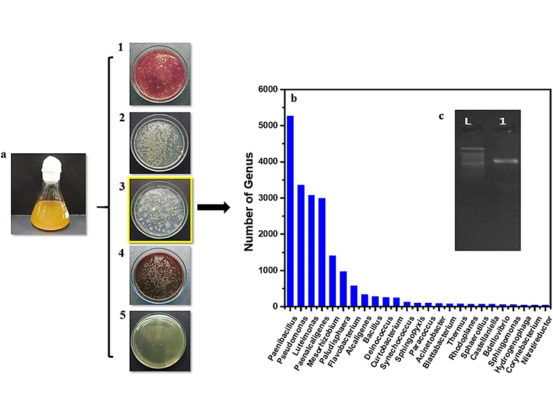
Abstract: The present study synthesizes carbon nanofibers (CNF) over a graphitic carbon nitride (g-C3N4) substrate without requiring an external carbon-source. In this novel route of the synthesis, g-C3N4 acts as the substrate as well as the internal source of carbon. Ni nanoparticles (NPs) dispersed in g-C3N4 catalyze the decomposition of triazine rings and N heterocycles in the material to form a web of CNF over g-C3N4. Tested for its catalytic activity towards the reduction of aqueous nitrobenzene (NB) using the hydrazine monohydrate reducing agent, Ni-CNF/g-C3N4 shows an approximately 95% conversion of NB. The high catalytic activity of the material is ascribed to the combined effects of g-C3N4, Ni NPs, and CNF. The present study has clearly established an efficient, easy, and inexpensive route for synthesizing CNF-based 3D nanostructures that are useful in many engineering applications including energy and environment.
Read More ...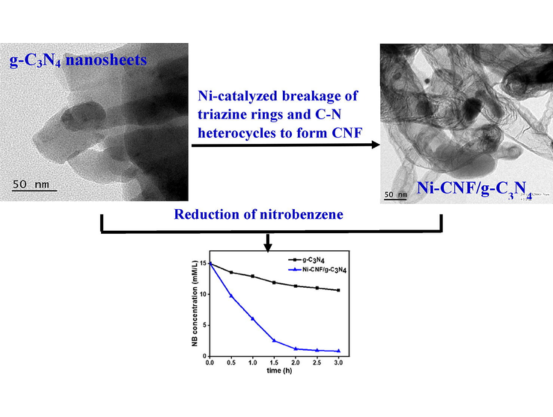
Abstract: Graphitic carbon nitride (g-C3N4)-supported ferric oxide (Fe2O3) nanocomposite modified with carbon nanofibers (CNFs) has been synthesized for the first time for photocatalytic H2-generation and the degradation of aqueous organics. In its first dual role, Fe2O3 served as the photocatalyst and the chemical vapor deposition (CVD) catalyst to grow CNFs over the g-C3N4 substrate. Time of CVD was found to be critical for synthesizing Fe2O3-CNF/g-C3N4 with a good photocatalytic efficiency. The synthesized materials were characterized for various physicochemical and photocatalytic properties. The creation of a Z-scheme heterostructure between g-C3N4 and Fe2O3 resulted in the greater H2-generation rate (2095 µmol/g h) than that (1119 µmol/g h) over the substrate. The photocatalytic degradation data showed ~ 95 and 91% removal of methylene blue and 4-nitrophenol in 180 and 300 min, respectively at 22 °C using the Fe2O3-CNF/g-C3N4 dose of 0.5 mg/mL. The photocatalytic reactions followed the indirect Z-scheme charge transfer path, with the graphitic CNFs acting as the electron-transfer medium between Fe2O3 and g-C3N4. The simple fabrication route and high photocatalytic efficiency of the ternary CNF-bridged Fe2O3-g-C3N4 composite system indicate the utility of the material in integrated environmental and energy applications including microbial fuel cells and microelectrolysis cells.
Read More ...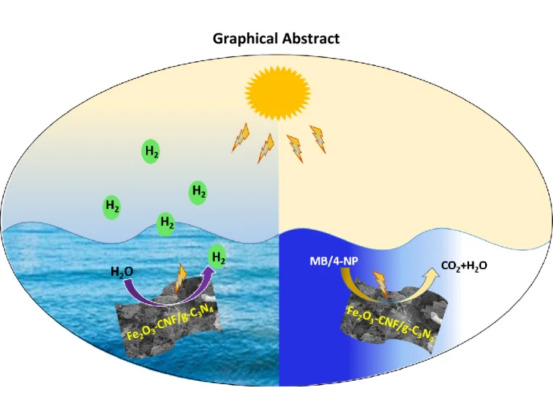
Abstract: An effective strategy to combat the adverse effects of rising CO2 levels in the atmosphere is to convert CO2 to value-added chemicals. Recently, microalgal technology has received attention for CO2 utilization considering that it provides a green pathway for producing the chemicals. The current study demonstrates the production of formate from CO2 using the Chlamydomonas reinhardtii and Spirulina microalgae. The production is enhanced using potassium (K)-doped graphitic carbon nitride (g-C3N4), a non-toxic and environmentally benign catalyst. The experiments performed in a photobioreactor show the maximum formate production over the K-g-C3N4-supported Chlamydomonas reinhardtii and Spirulina to be 1192 and 751 mg/L, respectively, which are 59 and 13 % higher than those in the corresponding uncatalyzed algal processes. Starch synthesis in the microalgae is aided by g-C3N4 in light, while potassium doping and a nitrogen blanket in the reactor increased the microalgae's ability to convert starch to formate in dark. The photocatalytic role of gCN in CO2 conversion by the microalgae was confirmed by scavenger analysis. A positive interaction between the microalgae and K-gCN was observed using the morphological and physicochemical characterization tests. Accordingly, the study confirmed that K-gCN played a dual role. It not only provided a suitable surface for the microalgae but also enhanced photocatalytic activity, which in turn improved formate production. A mechanistic insight of the step-wise conversion of CO2 to formate is proposed. In a first, this study has proposed a clean route to producing a low-carbon alternative.
Read More ...
Abstract:The monoclinic-scheelite (m-s) polymorph of BiVO4 has the highest photocatalytic activity, whereas tetragonal-zircon (t-z) has the lowest photocatalytic activity, which may be due to a higher band gap. However, t-z has the highest crystal symmetry, which makes it a more suitable candidate to form coherent type-II interfaces for the efficient separation of electron–hole pairs. Furthermore, the method of preparation (e.g. low temperature and moderate pH) of t-z is more facile compared to the m-s polymorph. Hence, in this report, we construct coherent isomaterial and heteromaterial type-II heterostructures by facet engineering of low index surfaces of t-z polymorph with different semiconductor materials (e.g. ZnO, TiO2, CdSe, and ZnS) by screening the band gap, band edge positions, and lattice misfit strain. On the basis of the calculated band-edge positions, the polymorphs of BiVO4 can form 212 combinations of the type-II interface, which reduces to 17 coherent interfaces with lattice misfit strain between 1.55% to 28.5% when translational symmetry, atomic positions, lattice mismatch, and bond complementarity have been imposed. Furthermore, the current study suggests that t-z polymorphs can form more coherent interfaces (4 out of 168), which may be due to its highest symmetry structure in comparison to previously formed 67 isomaterial and heteromaterial type-II heterostructure combinations of BiVO4 (1 out of 67), which suggests that t-z can be a suitable candidate for the formation of type-II coherent interfaces for PEC/PC applications.
Read More ...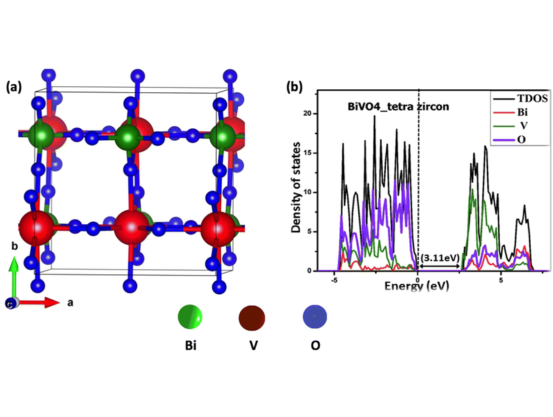
Abstract: Upconverting nanoparticles has a significant potential to enhance solar cell efficiency as a “spectral converter”. Here, we report a phase pure, cubic, upconverting BaGdF5:Er/Yb-doped nanocrystal accessible via ionic liquids that are combined with TiO2 to apply as the absorption layer in a dye-sensitized solar cell (DSSC) as a potential technology to harvest solar energy. Bright-green (520 and 540 nm) and red (665 nm) emissions were observed due to transitions of 2H11/2 + 4S3/2 → 4I15/2 and 4F9/2 → 4I15/2, respectively. The experimental data for 540 and 665 nm emission bands of BaGdF5:Er3+/Yb3+ nanoparticles have been fitted with a straight line with a slope of ∼2, which confirms the two-photon absorption process. It is also found that not only the overall upconversion intensity but also the IG/IR ratio has a significant effect on device efficiency. Under 1 sun illumination, cells fabricated with the BaGdF5:Er3+(1%)/Yb3+(10%)/TiO2 absorption layer showed the highest photon conversion efficiency (PCE) of 7.75% with current density Jsc = 15.9 mA/cm2. However, when only TiO2 is used as the absorption layer, a much lesser PCE of 4.60% along with Jsc = 9.6 mA/cm2 is obtained. Almost a 68.47% enhancement in photon conversion efficiency and a significant increase in current density (Jsc) (65.62%) for the BaGdF5:Er3+(1%)/Yb3+(10%)/TiO2-based device compared to the bare TiO2 cells promise the potential use of upconverting materials as a spectral converter in the DSSC and other solar cell devices.
Read More ...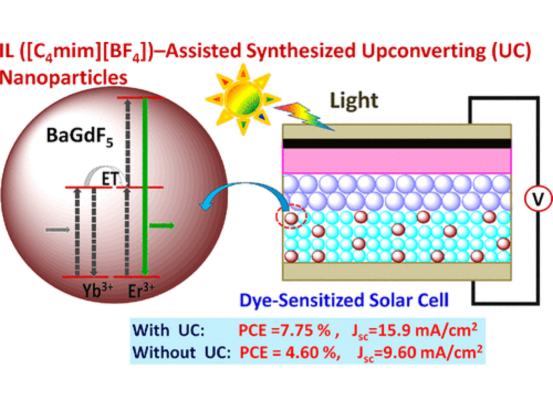
Abstract: The need for electrical energy is increasing every day as a result of economic growth, rising population, and massive technical advancements all over the world. Though the world is moving at a faster pace to increase the production of electricity from renewable resources, coal is still the dominating fuel and is used in most of the power plants. Therefore, to achieve sustainable development, the performance of the power plants must be analysed and evaluated. In this paper, several important criteria such as plant load factor, auxiliary consumption, consumption of coal, net generation, and absolute emissions of CO2, from five distinct power generating stations under West Bengal Power Development Corporation Limited (WBPDCL), have been considered for evaluation. The Fuzzy Analytic Hierarchy Process (F-AHP) has been used to determine the weights of the various criteria, and the Technique for Order of Preference by Similarity to Ideal Solution (TOPSIS) has been used to rank the power plants on the basis of performance score.
Read More ...
Abstract: The effect of non-ionic surfactants (Tween-20) in droplet-based systems where a prostate-specific antigen (PSA) laden droplet is placed on an anti-PSA immobilized PDMS substrate was investigated. The role of surfactants in such (antibody-antigen system with surface reaction) droplet-based systems has not been studied before and there are no studies involving surfactant-protein-colloids in droplet-based systems with surface reaction, and this is the motivation of the present work. In this article, we investigated the interactions between protein-surfactant-colloid systems in evaporating sessile droplets with antibody-antigen surface reactions using dynamic surface tension (DST), micro-PIV and confocal microscopy. The presence of Tween-20 showed dampening of the velocities in systems with surface reaction even though the Marangoni number was observed to increased. The dynamic surface tension curves of the pure Tween-20 samples were higher than those of the mixed samples (Tween-20+PS+PSA), indicating the influence of Tween-20 and its contribution to interfacial tension reduction. With an increase in the bulk concentration of Tween-20, the surface tension relaxations also increase implying that more surfactant molecules are transported to the interface and get adsorbed there leading to more homogeneous distribution of the surfactant, PS and PSA. The deposition patterns were homogeneous at all Tween-20 concentrations which is desired in biosensors. The results from this study can be useful for designing biosensors with reduced non-specific binding and lesser interfacial adsorption by incorporating the optimum concentration of Tween-20 in the droplets.
Read More ...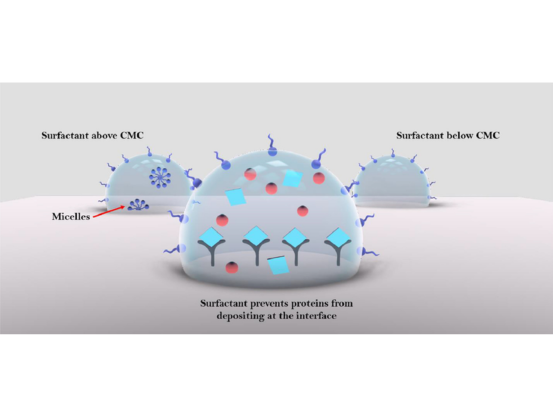
Abstract: Ammonia detection is needed in several sectors including environmental monitoring, automobile industry, and in medical diagnosis. Conducting polymers, such as polyaniline (PANI), have been utilized to develop NH3 sensors operating at room temperature. However, the performance of these sensors in terms of sensitivity and selectivity need improvement. Functionalization of conducting PANI with metal nanocomposites have shown improved sensor performance. In this work, we report a highly sensitive copper-based nanocomposite for NH3 detection. The novelty lies in utilization of copper-ethylenediamine (Cu-en) nanocomposite functionalized over PANI for gas sensing. Resistance of the 20 wt% Cu-en with PANI increased 3.8 times upon exposure to 100 ppm of NH3. The nanocomposite sensor detected NH3 concentrations as low as 2 ppm. Further, the sensing mechanism was studied by in-situ IV characteristics and impedance spectroscopy during NH3 exposure. NH3 showed ionic interaction with PANI, and Cu2+. The strong affinity of Cu2+ for the lone pair of NH3 enhanced the sensor response from 0.78 to 3.8 for 100 ppm of NH3 at 20 °C. The sensor response was completely recovered after heating at 75 °C, which indicates reusability of the sensor. The sensor showed selectivity for NH3 over ethanol and H2S. The response was reasonably stable after bending the flexible sensor for 1000 times at a radius of 5 mm.
Read More ...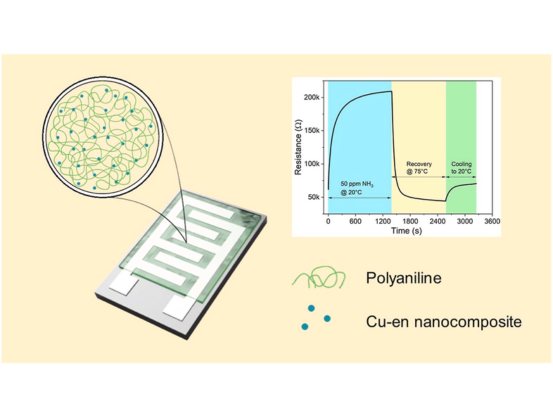
Abstract: The Ganga is the most sacred Indian river, and it influences the lifestyle of ∼400 million people. However, owing to several anthropogenic activities, biotic and abiotic pollutants have increased substantially. The water quality assessment of the Ganga river has indicated that the water is not potable along most of its stretch. Most of the pollutants originate from a lack of responsible waste dumping from industrial, farming, sewage sectors and religious activities and cremation practices. The level of dissolved oxygen and biological oxygen could be the reason for serious concerns about aquatic life and human health risks. In this context, the challenges associated with formulating a standard testing kit for the Ganga water from people friendly viewpoint and utilising their knowledge base is presented. Overall identified data from available sources have been classified in terms of sources, such as industrial, farming, various religious activities, cremation practices, and their possible effects on aquatic life and human health. The present level of pollution from all sources and accepted standards are discussed. Further, we have highlighted the need for understanding pollution from the people's perspective involved in various activities and postulated the information regarding the sensors that have been developed to identify a variety of pollutants in the water.
Read More ...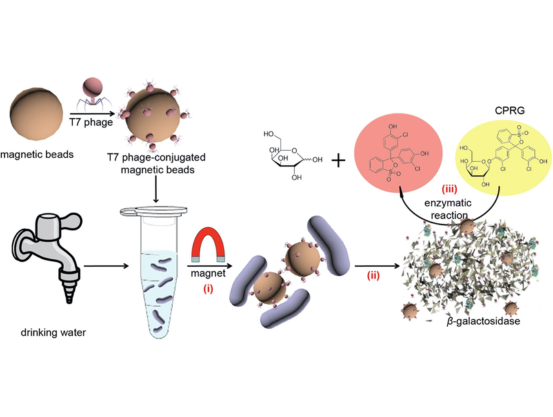
Abstract: The development of efficient nanomaterials with promising optical and surface properties for multifunctional applications has always been a subject of novel research. In this work, the study of highly efficient TiO2 nanorods (NRs) and Ta-doped TiO2 NRs (Ta-TiO2 NRs) synthesized by alkaline hydrothermal treatment followed by soaking treatment has been reported. NRs were investigated for their potential applications as recyclable/reproducible visible light active photocatalysts and surface-enhanced Raman scattering (SERS) substrates in wastewater treatment. NRs were characterized by various microscopic (scanning and transmission electron microscopy), spectroscopic (X-ray diffraction, X-ray photoelectron, UV–visible, photoluminescence, and Raman spectroscopy), and surface (Brunauer–Emmett–Teller) techniques. The NRs exhibited promising optical properties with a band gap of 2.95 eV (TiO2 NRs) and 2.58 eV (Ta-TiO2 NRs) showing excellent photo-degradation activities for methylene blue (MB) dye molecules under natural sunlight. Particularly, Ta-TiO2 NRs showed enhanced response as visible light active photocatalysts in normal sunlight and also as SERS substrate attributed to the additional defects introduced by Ta doping. It could be explained by the combined effect of doping-induced enhanced visible light absorption and charge transfer (CT) properties of Ta-TiO2 NRs. Furthermore, Ta-TiO2 NRs were investigated for their long-term stability, reproducibility of the data, and recyclability in view of their potential applications in water treatment.
Read More ...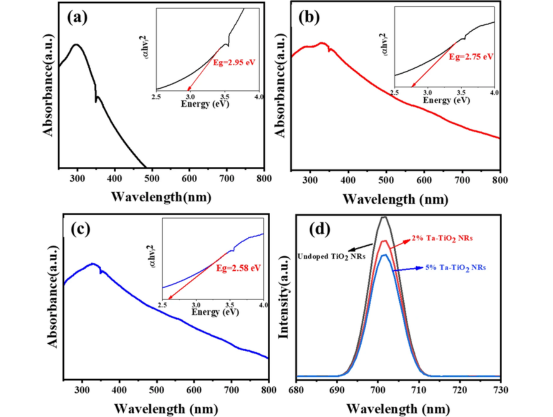
Abstract: Dry reforming of methane (DRM) presents a sustainable approach to convert greenhouse gases CO2 and CH4 into syngas. However, the industrialization of DRM is hindered by the short catalyst lifespan due to carbon deposition. Carbon deposition on Ni-catalysts is attributed to Ni step edges, which serve as carbon nucleation centers. We propose an innovative strategy to prevent carbon nucleation by modulating Ni size to eliminate Ni step edges. Ni was loaded on MCM-41, SBA-15, and DFNS (dendritic fibrous nanosilica) to prepare three distinct Ni catalysts. By altering the precursor concentration using the proposed microemulsion antisolvent coprecipitation method, we successfully adjusted the Ni size on DFNS. Ni particles with a diameter of ∼5 nm were obtained on DFNS, exhibiting excellent Ni dispersion and a physical spacing effect due to the specific preparation method and porous structure. Carbon deposition rates on Ni/MCM-41 and Ni/SBA-15 were 30.23 mgc·gcat·–1·h–1 and 16.33 mgc·gcat·–1·h–1, respectively. Remarkably, the carbon deposition rate on Ni/DFNS was only 0.15 mgc·gcat·–1·h–1. The gasification rate of deposited C to CO on the 5 nm Ni particles loaded on Ni/DFNS was five times that of the polyhedral Ni particles of Ni/MCM-41. This was attributed to the elimination of Ni step edges, which weakened C adsorption strength and enhanced the reaction of deposited C with O* to form CO. Our proposed catalyst preparation strategy is based on designing the catalyst microstructure to eliminate carbon nucleation sites. This research provides guidance for designing or preparing Ni-based catalysts for DRM with reduced carbon deposition.
Read More ...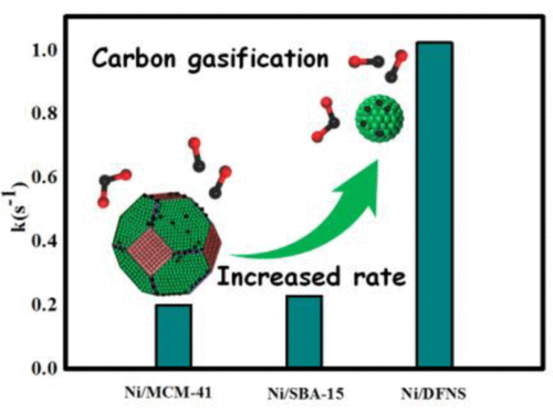
Abstract: Liquid metal battery (LMB) is considered a potential contender for grid-scale energy storage systems. However, high operating temperatures (>400 °C) leading to higher operational costs limit its commercial application. Therefore, the current work focuses on reducing the melting temperature of electrodes and electrolytes below 300 °C by compositional engineering. Moreover, this study utilizes earth-abundant elements like Zn (with less reliance on Li), in Zn–Sn||Bi–Pb LMB system. The composition of LiCl in the electrolyte is varied to optimize the battery performance, especially the energy efficiency and overpotential while maintaining an operating temperature of <275 °C. It is found that as the LiCl content in the electrolyte salt increases (5–30 Mol%), the overpotential of the battery decreases (0.9–0.3 V), and the energy efficiency of the charge-discharge process improves (14.5%–80.9%) owing to the better ionic conductivity of LiCl. For the optimized LiCl concentration of 30 Mol% LiCl in the electrolyte, the fabricated LMB exhibit good cyclability (no degradation till 100 cycles), a high discharging voltage plateau of 0.92 V, 24.6 mAh charge storage capacity, and a low operating temperature of 275 °C, which is the lowest operating temperature reported so far in a Zn-based LMB system.
Read More ...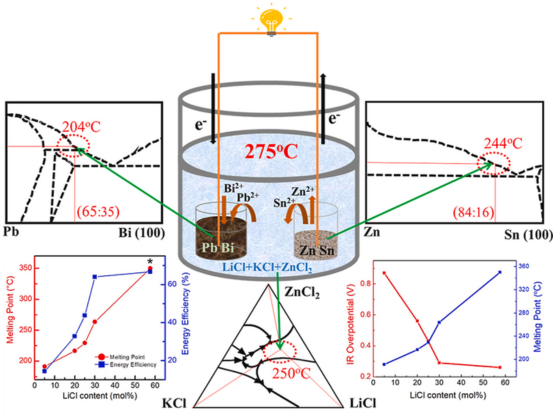
Abstract: Dry reforming of methane (DRM) is a feasible route to realize the resource utilization of greenhouse gases CO2 and CH4. The Ni-based catalyst is recognized as a potential catalyst for the industrialization of DRM. However, catalyst deactivation caused by carbon deposition is a challenge. Providing enough active oxygen species to accelerate the reaction between CHx (x = 0–3) and oxygen species is the key to inhibit coking. Ni-based catalysts loaded on a Zr-doped Ce1–xZrxO2 nanorod were prepared by a one-step hydrothermal method. Benefiting from lattice distortion caused by Zr doping, the Ni/Ce0.95Zr0.05O2 catalyst showed the best catalytic activity and stability. Compared with the Ni/CeO2 catalyst, the activation energy of CH4 and CO2 decreased by 20 and 22%, respectively. The 100 h stability test showed that the Ni/CeO2 catalyst was 10% deactivated, and the carbon deposition rate was 0.82 mgc·gcat·–1·h–1, while the Ni/Ce0.95Zr0.05O2 catalyst showed excellent stability. The extensive characterization of the catalysts indicated that the enhancement in DRM activity upon Zr doping could be attributed to the increase of oxygen vacancies and the improvement in lattice oxygen mobility. However, excessive Zr doping formed ZrO2 covering oxygen vacancies, resulting in decreased catalytic activity and stability. The results showed that lattice oxygen over the Ni/Ce0.95Zr0.05O2 catalyst not only participated in the oxidation of carbon intermediates but also contributed to the deep dissociation of CH4 over Ni through an oxygen-mediated dissociation pathway. Similarly, the redox cycle on the oxygen vacancies was also important for enhancing the CO2 adsorption activation to relieve the coking of the catalyst.
Read More ...
Abstract: Catalytic reforming for hydrogen production is a bridge to sustainable energy. Coking is a big challenge for the industrialization of DRM. The key is to maintain a balance between the formation rate of *C and that of *O. A novel preparation strategy of Ni-Co nano alloy catalysts was proposed with microemulsion coupling with antisolvent extraction strategy. The prepared nanoparticles were highly dispersed and Ni,Co were closely adjacent. Compared with the monometallic 10Ni0Co/SiO2 catalyst and 0Ni10Co/SiO2 catalyst, the as-prepared bimetallic 5Ni5Co/SiO2 nano alloy catalyst showed the best catalytic activity. On the monometallic 10Ni0Co/SiO2 catalyst, owing to the faster cracking of methane on Ni particles, the catalytic activity decreased 10% by coking during the 50 h test. However, 0Ni10Co/SiO2 catalyst was deactivated by the oxidation of Co. In the 100 h test of 5Ni5Co/SiO2 bimetallic catalyst, the catalytic activity remained stable. TPSR showed that the dissociation of methane and the generation of *C was slightly inhibited and the activation of CO2 was intensified. More activated *O enhanced the reaction of *C or *CHx and *O. The anti-coking performance was improved. The results provide implications for anti-coking catalysts for catalytic reforming.
Read More ...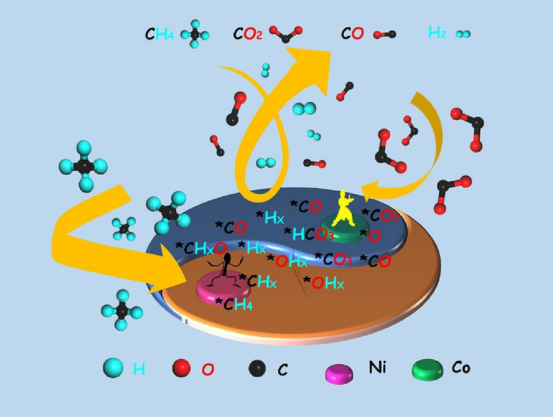
Abstract: The motion of biological swimmers in typical bodily fluids is modelled using a system of micellar solubilization driven active droplets in a viscoelastic polymeric solution. The viscoelastic nature of the medium, as perceived by the moving droplet, characterized by the Deborah number (De), is tuned by varying the surfactant (fuel) and polymer concentration in the ambient medium. At moderate De, the droplet exhibits a steady deformed shape, markedly different from the spherical shape observed in Newtonian media. A theoretical analysis based on the normal stress balance at the interface is shown to accurately predict the droplet shape. With a further increase in De, time-periodic deformation accompanied by an oscillatory transition in swimming mode is observed. The study unveils the hitherto unexplored rich complexity in the motion of active droplets in viscoelastic fluids.
Read More ...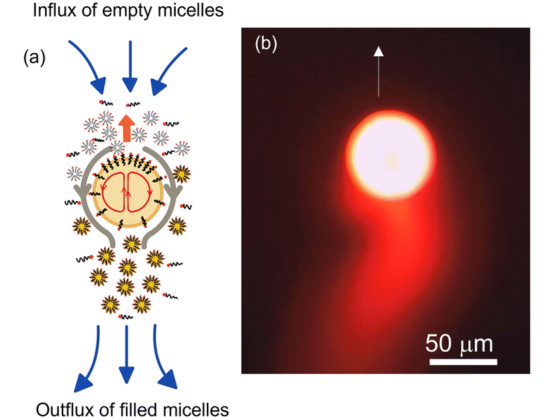
Abstract: Self-propelled Janus colloids (JCs) have recently gained much attention due to their ability to move autonomously and mimic biological microswimmers. This ability makes them suitable for prospective drug/cargo-delivery applications in microscopic domains. Understanding their dynamics in surroundings doped with macromolecules such as polymers is crucial, as most of the target application media are complex in nature. In this study, we investigate the self-diffusiophoretic motion of hydrogen peroxide-fuelled SiO2–Pt JCs in the presence of dilute amounts of poly(ethylene oxide) (PEO). Despite the addition of PEO chains producing a Newtonian behavior with negligible increase in viscosity, the ballistic movement and rotational fluctuations of active JCs are observed to be significantly suppressed. With an increase in the polymer concentration, this leads to a transition from smooth to jittery to cage-hopping to the arrested motion of active JCs. We further propose that the anisotropic interaction of the polymers with the JC increases the “local drag” of the medium, resulting in the unusual impediment of the active motion.
Read More ...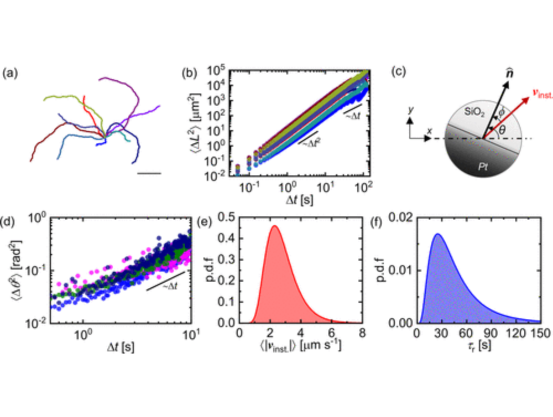
Abstract: The complexity of the topological and combinatorial configuration space of MXenes can give rise to gigantic design challenges that cannot be addressed through traditional experimental or routine theoretical methods. To this end, we establish a robust and more broadly applicable multistep workflow using supervised machine learning (ML) algorithms to construct well-trained data-driven models for predicting the hydrogen evolution reaction (HER) activity of 4500 MM′XT2-type MXenes, where 25% of the materials space (1125 systems) is randomly selected to evaluate the HER performance using density functional theory (DFT) calculations. As the most desirable ML model, the gradient boosting regressor (GBR) processed with recursive feature elimination (RFE), hyperparameter optimization (HO) and the leave-one-out (LOO) approach accurately and rapidly predicts the Gibbs free energy of hydrogen adsorption (ΔGH) with a low predictive mean absolute error (MAE) of 0.358 eV. Based on these observations, the H atoms adsorbed directly on top of the outermost metal-atom layer of the MM′XT2-type MXenes (site 1) with Nb, Mo and Cr metals with O functionalization are discovered to be highly stable and active for catalysis, surpassing commercially available platinum-based counterparts. Overall, the physically meaningful predictions and insights of the developed ML/DFT-based multistep workflow will open new avenues for accelerated screening, rational design and discovery of potential HER catalysts.
Read More ...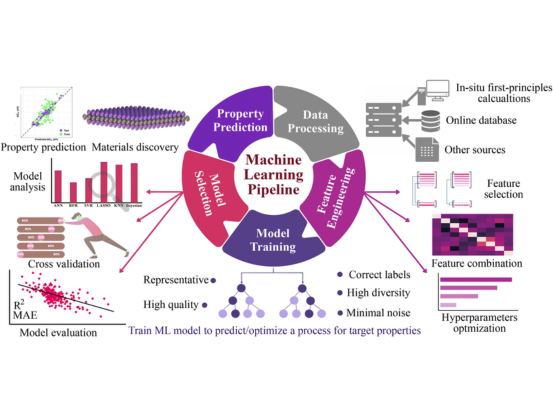
Abstract: The nanoscale association domains are the ultimate determinants of the macroscopic properties of complex fluids involving amphiphilic polymers and surfactants, and hence, it is foremost important to understand the role of polymer/surfactant concentration on these domains. We have used coarse-grained molecular dynamics simulations to investigate the effect of polymer/surfactant concentration on the morphology of poly(ethylene oxide)-poly(propylene oxide)-poly(ethylene oxide) (PEO-PPO-PEO, i.e., pluronics or poloxamers) block copolymer, and ionic surfactants sodium dodecyl sulfate (SDS), mixed micelles in aqueous solution. The proclivity of the surfactant to form the mixed micelles is also probed using umbrella sampling simulations. In this study, we observed that the core of the pluronic + SDS formed mixed micelles consists of PPO, the alkyl tail of SDS, and some water molecules, whereas the PEO, water, and sulfate headgroups of SDS form a shell, consistent with experimental observations. The micelles are spherical at high-pluronic/low-SDS compositions, ellipsoidal at high-SDS/low-pluronic compositions, and wormlike-cylindrical at high-pluronic/high-SDS compositions. The transitions in micelle morphology are governed by the solvent accessible surface area of mixed aggregates, electrostatic repulsion between SDS-headgroups, and dehydration of PEO and PPO segments. The free energy barrier for SDS escape is much higher in mixed micelles than in pure SDS micelles, indicating a stronger tendency for SDS to form pluronic-SDS mixed micelles.
Read More ...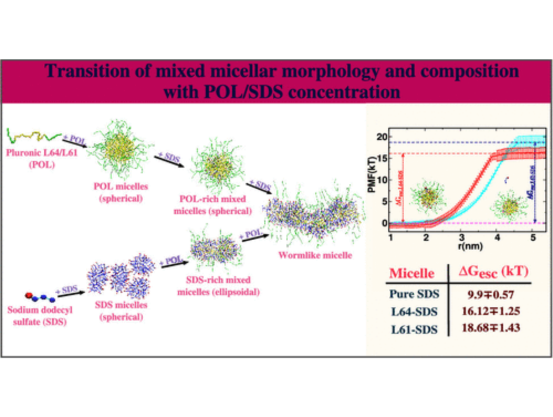
Abstract: A database of hypothetical metal–organic frameworks (hMOFs) was investigated in search of top-performing adsorbents for the separation process of xylene isomers and ethylbenzene mixture. The structural properties of individual hMOF are calculated to understand the correlation between the properties with adsorption capacity or selectivity. The high-throughput staged screening of the hMOF database is performed and screened. The simulations of hMOF with a gas mixture were conducted at 373 K and 30 kPa using a multicomponent grand canonical Monte Carlo method to obtain the para-xylene selectivity. The top five hMOFs showed significantly better performance of all and compared to previously discovered materials. The top hMOFs were further simulated at different pressures to obtain the adsorption isotherms. Further, the energetic contribution of organic linkers and inorganic metal nodes toward competitive adsorption was studied to further understand the enhanced interaction between hMOF and para-xylene.
Read More ...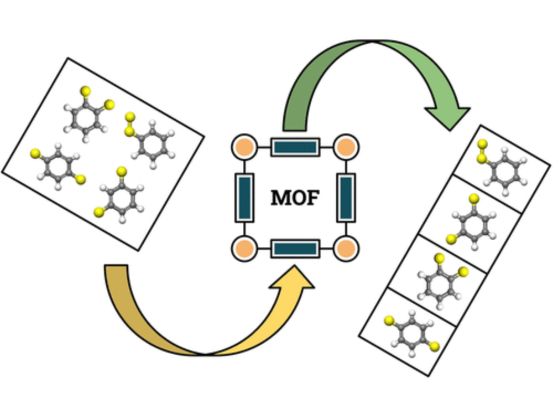
Abstract: The effect of preheating Amberlyst-15 catalyst used for the biodiesel production reaction of Karanja oil was studied. The preheated Amberlyst-15 samples were characterized for their surface area and pore volume and by SEM, TGA and FTIR spectroscopy. A preheat temperature of 473 K was found to optimum. At this temperature, the surface area had increased and the sulfonic acid groups of Amberlyst-15 were retained. At 473 K preheated Amberlyst-15 gradually deactivated with reuse from a biodiesel yield of 85% to 27% in four runs at a reaction temperature of 393 K and methanol to oil ratio of 60:1. For the power-law model, the reaction order was 0.65, the rate constant at 373 K was 0.027 h-1 and activation energy was 86.98 kJ/mol.
Read More ...
Abstract: In the present study, a series of Ni-Al2O3 catalysts with different Ni loadings were synthesized and tested for the tri-reforming of methane (TRM). The prepared catalysts were characterized by using a variety of techniques. Reduction studies of all high-temperature calcined catalysts revealed the presence of strong metal-oxide interaction with the γ-Al2O3 support. Furthermore, with an increase in the metal amount, the crystallite size of metallic-Ni and metal-support interaction decreased, reached a minimum for the 15Ni-Al catalyst, and then increased for the 22.5Ni-Al catalyst. However, the active metal dispersion increased with an increase in Ni content from 5 wt.% to 15 wt.%, and an additional increase in the metal loading decreased the metal dispersion. 15Ni-Al showed the highest dispersion of 8.6%. The influence of metal amount on catalytic activity was evaluated by carrying out the TRM reaction under ambient pressure and 600 °C. The experimental results showed an enhancement in catalytic activity with an increase in Ni loading from 5 wt.% to 15 wt.%. However, a further increase in Ni amount reduced the catalytic activity due to a decrease in Ni dispersion. The CH4 and CO2 conversions during TRM are relatively constant with time-on-stream, and no carbon deposits were detected. The H2/CO ratio was greater than three for all the catalysts. The superior activity of 15 wt.% Ni-Al2O3 was attributed to the higher Ni dispersion and large availability of active sites. Thus, for the TRM reaction, an optimum loading of 15 wt.% Ni in the xNi-Al catalyst was observed for this alumina support.
Read More ...
Abstract: Catalyst and process improvement strategies for dry reforming of methane (DRM) are shown by enhancing the performance of an existing Ni/Al2O3 catalyst and adding oxygen to the feed. Alumina-supported Ni-Co catalyst, Ni/Co molar ratio = 3, was synthesized and calcined at 500 and 850 °C to take advantage of the possible strong metal-support interactions. The freshly reduced catalysts contained Ni-Co alloys. Higher CH4 and CO2 conversions, H2 and CO yields and H2/CO ratio during DRM and oxidative dry reforming of methane (ODRM) were achieved at 600 and 750 °C and two space-velocities for Ni3Co-500 due to a higher effective dispersion of 4.9 %. Significant carbon formation and activity loss occurred during DRM. Increasing the reaction temperature and/or with O2 co-feed increased the CH4 conversion. The outlet concentrations were stable, and carbon formed was significantly less. Changes in the crystallite size and near-surface alloy composition in the spent catalyst were detected.
Read More ...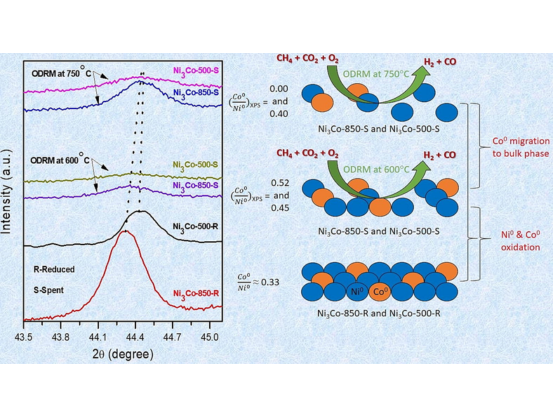
Abstract:
Read More ...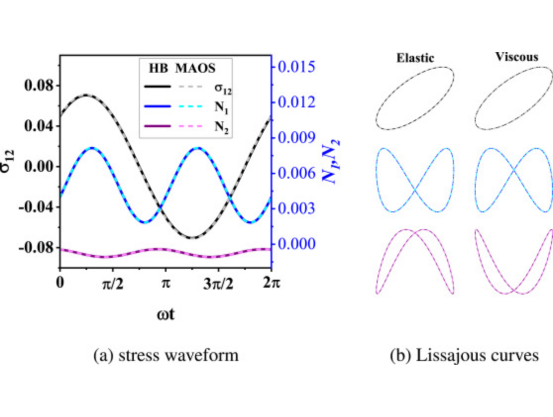
Abstract: Rheological characterization of complex fluids subjected to cyclic shear-rate sweep often exhibits hysteresis. Since both viscoelastic and thixotropic materials show hysteresis loops, it is important to understand distinguishing features (if any) in the same shown by either. Lately, there has been substantial work that attempts to relate the area enclosed by the hysteresis loop with the manner in which shear rate is varied in the cycle, in order to infer thixotropic parameters of a material. In this work, we use the nonlinear Giesekus model to study its response to the application of cyclic shear-rate sweep. We find that this model produces each type of qualitatively similar hysteresis loop that has hitherto been ascribed to thixotropic materials. We also show that the area of the hysteresis loop for a viscoelastic material as a function of sweep rate shows bell-shaped/bi-modal curves as has been observed for thixotropic materials. This study illustrates that caution needs to be exercised while attributing hysteresis loops and associated features observed in a material exclusively to thixotropy. Another feature related to the hysteresis loop is the occurrence of shear banding instability. We find that viscoelastic hysteresis may not have any connection to shear banding instability.
Read More ...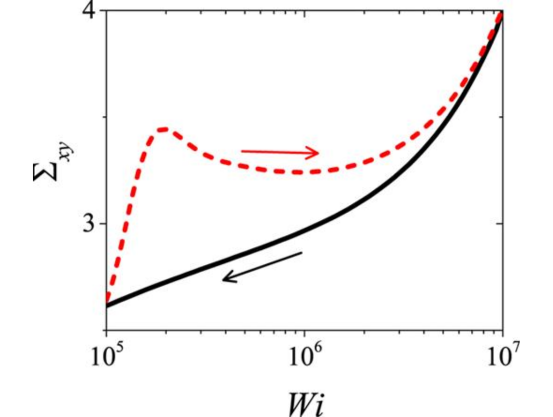
Abstract: Thixotropy is a phenomenon related to time dependent change in viscosity in the presence or absence of flow. The yield stress, on the other hand, represents the minimum value of stress above which steady flow can be sustained. In addition, the yield stress of a material may also change as a function of time. Both these characteristic features in a material strongly influence the steady state flow curve of the same. This study aims to understand the interrelation between thixotropy, yield stress, and their relation with the flow curve. In this regard, we study five thixotropic materials that show yield stress. The relaxation time of all the five systems shows power-law dependence on aging time with behaviors ranging from weaker than linear, linear to stronger than linear. Furthermore, the elastic modulus and yield stress have been observed to be constant for some systems while time dependent for the others. We also analyze the experimental behavior through a viscoelastic thixotropic structural kinetic model that predicts the observed experimental behavior of constant as well as time-dependent yield stress quite well. These findings indicate that a nonmonotonic steady-state flow curve in a structural kinetic formalism necessarily leads to time-dependent yield stress, while constant yield stress is predicted by a monotonic steady-state flow curve with stress plateau in the limit of low shear rates. The present work, therefore, shows that thixotropic materials may exhibit either monotonic or nonmonotonic flow curves. Consequently, thixotropic materials may show no yield stress, constant yield stress, or time-dependent yield stress.
Read More ...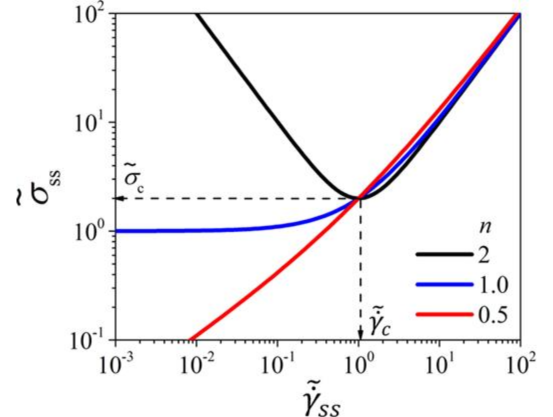
Abstract: A system undergoing sol–gel transition passes through a unique point, known as the critical gel state, where it forms the weakest space spanning percolated network. We investigate the nonlinear viscoelastic behavior of a colloidal dispersion at the critical gel state using large amplitude oscillatory shear rheology. The colloidal gel at the critical point is subjected to oscillatory shear flow with increasing strain amplitude at different frequencies. We observe that the first harmonic of the elastic and viscous moduli exhibits a monotonic decrease as the material undergoes a linear to nonlinear transition. We analyze the stress waveform across this transition and obtain the nonlinear moduli and viscosity as a function of frequency and strain amplitude. The analysis of the nonlinear moduli and viscosities suggests intracycle strain stiffening and intracycle shear thinning in the colloidal dispersion. Based on the insights obtained from the nonlinear analysis, we propose a potential scenario of the microstructural changes occurring in the nonlinear region. We also develop an integral model using the time-strain separable Kaye–Bernstein–Kearsley–Zapas constitutive equation with a power-law relaxation modulus and damping function obtained from experiments. The proposed model with a slight adjustment of the damping function inferred using a spectral method, compares well with experimental data at all frequencies.
Read More ...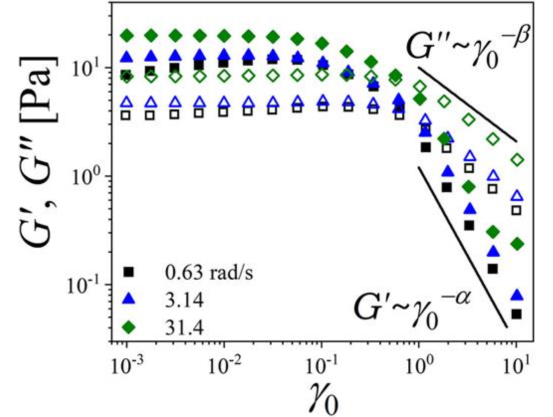
Abstract: While undergoing gelation transition, a material passes through a distinctive state called the critical gel state. In the neighborhood of this critical gel state, how viscosity, equilibrium modulus, and relaxation times evolve are correlated by scaling relations, and their universality has been validated for materials undergoing the sol-gel transition. In this work, we extend this approach for the gel-sol transition of a thermoresponsive polymeric system of aqueous poly(vinyl alcohol) (PVOH) gel that passes through the critical state upon increasing temperature. We observe that, in the neighborhood of the critical gel state, the equilibrium modulus and viscosity demonstrate a power law dependence on the relative distance from the critical state in terms of normalized temperature. Furthermore, the relaxation times in the gel and the sol state shows symmetric power law divergence near the critical state. The corresponding critical power law exponents and the dynamic critical exponents computed at the critical gel-sol transition state validate the scaling and hyperscaling relations originally proposed for the critical sol-gel transition very well. Remarkably, the dependence of complex viscosity on frequency at different temperatures shows a comprehensive master curve irrespective of the temperature ramp rate independently in the gel and the sol state. This observation demonstrates how the shape of relaxation time spectrum is independent of both the temperature as well as the ramp rate. Since sol-gel and the gel-sol transitions are opposite to each other, the applicability of the scaling relations validated in this work suggests broader symmetry associated with how the structure evolves around the critical state irrespective of the direction.
Read More ...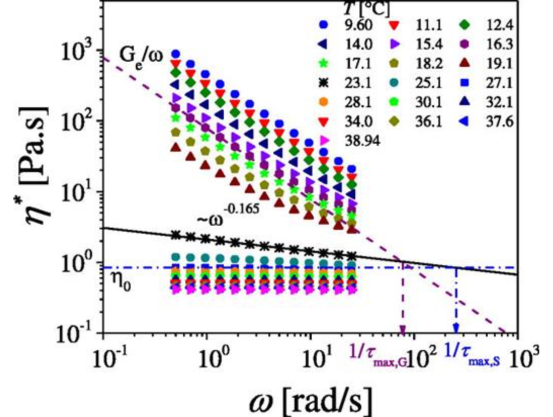
Abstract: We study the dynamics of shear startup of the Johnson-Segalman and non-stretching Rolie-Poly models using nonlinear simulations. We consider cases where the startup is from zero shear rate to shear rates in both the monotonic and nonmonotonic regions of the constitutive curve. For the Johnson-Segalman model, which exhibits a shear stress overshoot during startup, our nonlinear simulations show that transient shear banding is absent regardless of whether the start-up shear rate is in the monotonic or nonmonotonic regions of the constitutive curve. In the latter case, while there is clearly an inhomogeneity en route to the banded state, the extent of shear banding is not substantially large compared to that of the eventual banded state. Marked inhomogeneity in the velocity profile is predicted for the non-stretching Rolie-Poly model only if the solvent to solution viscosity ratio is smaller than O(10^(-3), but its occurrence does not appear to have any correlation with the stress overshoot during startup. These inhomogeneities are also very sensitive to initial amplitude of perturbations and the magnitude of Reynolds number. Our nonlinear simulations show that the transient evolution during shear startup is quite sensitive to the Reynolds number when the solvent viscosity parameter is much smaller than unity for non-stretching Rolie-Poly model. However, the results of the Johnson-Segalman model are very robust for solvent to solution viscosity greater than O(10^(-3) and do not reveal any transient shear banding during shear startup.
Read More ...
Abstract:A hypodermic syringe needle, undergoing axial vibration, can puncture a soft solid at a load smaller than that is required when it is driven at a uniform axial velocity. While this decrease in insertion load is a function of dynamical features of the insertion process, geometric parameters and elastic modulus of the solid, the optimal range of values at which the effect of vibration becomes apparent and in fact maximize is not yet known. In this report, we have carried out systematic displacement-controlled puncturing of a soft yet brittle hydrogel material using syringe needles of range of diameter, at varying insertion speed, while subjecting it also to longitudinal vibration at different frequency and amplitude. After analyzing the experimental data, we have identified the relevant dimensionless quantities that can help identify the range of parameter values for which decrease in the insertion load of the needle maximizes. Our phenomenological model shows that the average axial speed of insertion of the needle and amplitude of vibration of the needle, both affect the percentage decrease in the puncturing load quite prominently. However, within the range of vibration frequency examined, its effect was not found to be significant.
Read More ...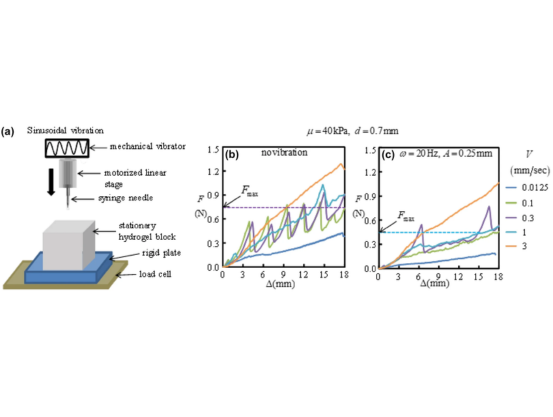
Abstract: We investigate the equilibrium of an axisymmetric system consisting of sessile and pendent drops on pre-stretched nonlinear elastic membranes. The membrane experiences large deformations due to the drop's weight and interfacial interactions. We first show that force balance alone leads to non-unique equilibrium solutions. Identifying the system's equilibrium with the minimum of its free energy, we then demonstrate that the equilibrium solution is made unique by requiring the continuity of meridional stretches across the three-phase contact circle. For a special class of nonlinear elastic materials – I2 materials – we then compute the equilibrium configurations of the drop–membrane system for a range of drop volumes and membrane pre-tensions. Finally, the present work facilitates two important applications: (a) the membrane's pre-tension and current tension are related exactly to help in utilizing the system as an elastocapillary probe for membrane pre-tension and (b) we suggest an experimental protocol for measuring the membrane's surface properties.
Read More ...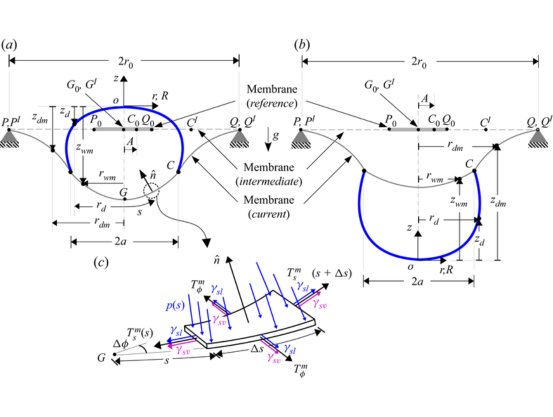
Abstract: Density segregation of multi-component granular mixtures in a dense, gravity-driven flow over a rough and bumpy periodic chute surface is studied using theory and simulations. An existing theoretical model for predicting the steady-state concentration field of each species in a binary mixture using the forces acting on the particles is generalised for multi-component mixtures in this work. In addition, the rheological model for binary mixtures is also extended to multi-component mixtures. In contrast to the percolation velocity-based empirical segregation models that do not account for the rheology and need prior knowledge of the velocity field, the present approach accounts for the inter-coupling of rheology with segregation. The momentum balance equations are solved, along with the mixture rheological model as well as the multi-component density segregation model, to obtain concentration fields using an iterative numerical method. The theoretical predictions are compared with discrete element method (DEM) simulations for ternary, quaternary and quinary granular mixtures differing in density. The steady-state profiles for the concentration of different species as well as other flow properties predicted from the theory are in excellent agreement with the DEM simulation results for a variety of compositions over a range of inclination angles for different density ratios. Through this work, we take the first essential step towards proposing a generalised particle force-based segregation theory for multi-component mixtures differing in size and/or density.
Read More ...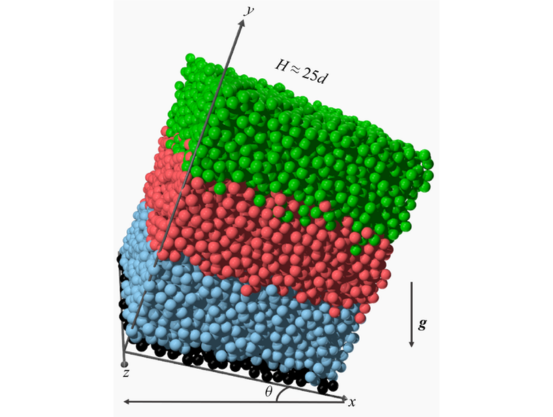
Abstract: The classical role of C-terminal binding protein (CtBP) is that of a global corepressor. However, its exact mechanism of repression is not known. In this review, we elucidate the repression motif used by CtBP. Further, we provide other unifying features of its mechanism of action. For example, in the presence of a high NADH/NAD+ ratio in the cell, causing a low glycolytic condition, the NADH-bound dimeric form of CtBP causes global repression, maintaining balances and homeostases of many cellular processes, under the cell surveillance of p53 and NFkB. In contrast, in the presence of a low NADH/NAD+ ratio, causing a high glycolytic condition, the NADH-free monomeric form of CtBP blocks p53 function and NFkB-mediated transcription. Further, a low NADH/NAD+ ratio upsets the homeostases and balances in the absence of the cell surveillances of p53 and NFkB, causing global instability, the dominant outcome of CtBP's action in carcinogenesis, in cells in a high glycolytic state.
Read More ...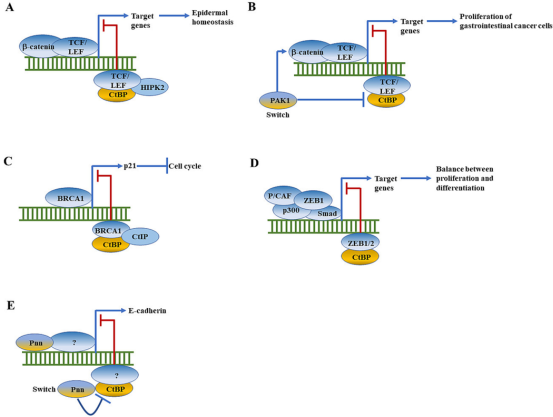
Abstract: Electrocatalytic transformation of CO2 to formic acid is typically realized via bi-hydrogenation process, which is remarkably challenging because of high thermodynamic stability and chemical inertness of the intermediate. Here, we explored the surface hydroxylation mechanism for CO2 conversion into formic acid over OH-terminated MXenes that can effectively circumvent the thermodynamic sink of the conventional bi-hydrogenation process by capturing additional hydrogen from the surface. The observed unique CO2RR activity can be attributed to the reactive H atom on the OH-terminated MXenes. The facile capture of (H) from OH-terminated MXenes confirm the viability of surface-hydroxylation mechanism. In addition, the ultra low work functions (1.72–2.27 eV) of such materials demonstrate the significance of functional groups in deciding the surface electrostatic potential of MXenes during the etching process. Overall, the present study bypass the thermodynamic constraints hampering the formation of formic acid by eliminating the intermediate step in the CO2 hydrogenation reaction and is likely to have considerable implications in the fields of catalytic chemistry and CO2 conversion.
Read More ...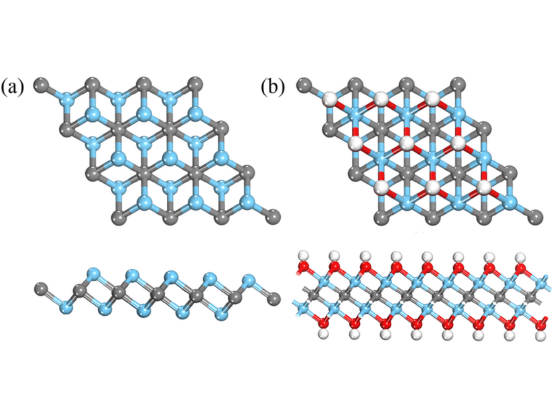
Abstract: Machine learning (ML) and artificial intelligence (AI) have enabled transformative impact on materials science by accelerating cutting-edge insights from computational methods and their analysis to hitherto unattainable scales. Such an assembly of linear algebra and statistical methods can facilitate the conceptual development of flexible techniques by finding mechanism/information/hidden pattern in a data set. The present review provides basic information about the classification of ML methodology and its workflow. These sections also elaborate on the advantages and limitations of various ML algorithms for solving problems in materials science and reviewing cases of success and failure. Subsequently, we show how these techniques can uncover the complexities in several quantitative structure–property relationships to design and discover novel materials for various applications. We conclude our review with an outlook on present research challenges, problems, and potential future perspectives in the field of machine learning. Overall, this review can serve as a fundamental guide to amplify the adoption of such tools and methods by materials scientists across academia and industry.
Read More ...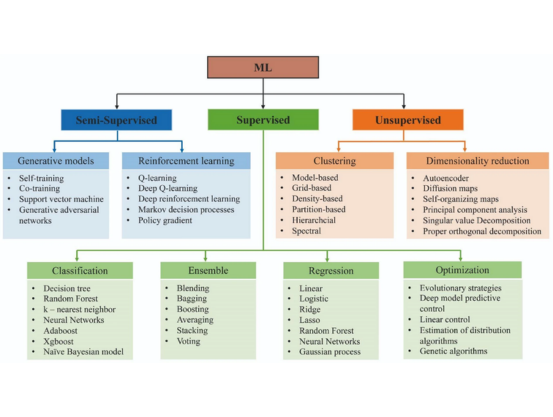
Abstract: Molecules that can be triggered between different states, molecular switches, are considered as the building blocks for molecular electronics. The chemical nature of the molecular switches is decisive in controlling the mechanism/energy barrier of switching and the life time of different states. Here, we investigate the electronic structure, switching barrier, and electron/hole-induced switching of an adlayer of three different azobenzene (AB) derivatives on graphite surface. The adlayers of AB derivatives with carboxyl group form a hydrogen-bonded dimer-based assembly and the derivative with the thiocyanate group forms van der Waals-stabilized assembly. While all the molecules in the adlayer can be individually switched using electron/hole, the switching probability depends on their chemical nature. We use a combination of scanning tunneling microscopy and concomitant density functional theory calculations to demonstrate the switching probability of different AB derivatives. Molecules that are having strong inter-molecular interactions within the adlayer show low switching probability compared to the one having weak inter-molecular interaction. Additionally, we observe that the molecule–surface interaction also contributes to the switching.
Read More ...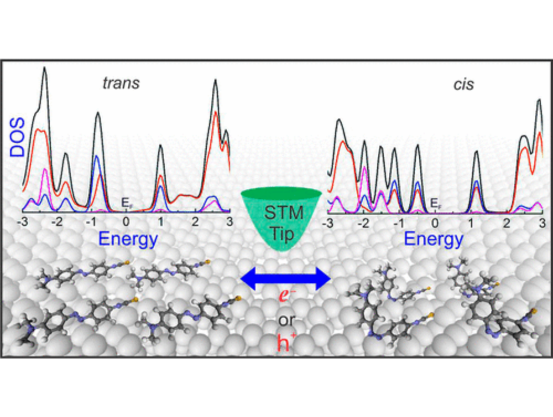
Abstract: Understanding the nucleation behavior of water in dilute polymeric solutions is quintessential for the development of suitable artificial ice recrystallization inhibition (IRI) agents. Although poly(vinyl alcohol) (PVA) is found to be one of the most potent biomimetic IRI agents, the molecular understanding of the nucleation behavior of water in the presence of PVA is still lacking. Here, we use molecular dynamics to elucidate the role of concentration, degree of supercooling, degree of polymerization, and amphiphilicity of PVA and PVA-like polymers on the homogeneous nucleation of water in dilute polymeric solutions using the seeding method. Using classical nucleation theory (CNT), our simulations indicate an increase in the chemical potential difference between ice and melt that favors ice nucleation. However, it also predicts a significant increase in the ice–melt interfacial energy that impedes nucleation. The relative increase in the interfacial energy dominates the increase in the chemical potential difference, which results in a decrease in the nucleation rate of water with an increase in the solute concentration. This study contradicts the previous simulation study that suggested the promotion of homogeneous ice nucleation by PVA and supports the experimental observations of the heterogeneous origins of ice nucleation. Our results also suggest the non-classical origins of ice nucleation in polymeric solutions and the limitation of the CNT in predicting heterogeneous ice nucleation in polymeric solutions.
Read More ...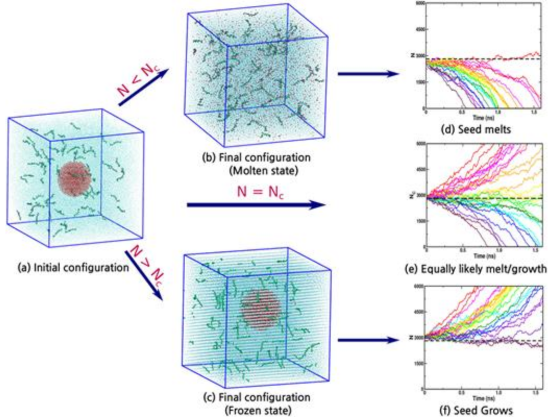
Abstract: Fusing high-throughput quantum mechanical screening techniques with modern artificial intelligence strategies is among the most fundamental ─yet revolutionary─ science activities, capable of opening new horizons in catalyst discovery. Here, we apply this strategy to the process of finding appropriate key descriptors for CO2 activation over two-dimensional transition metal (TM) carbides/nitrides (MXenes). Various machine learning (ML) models are developed to screen over 114 pure and defective MXenes, where the random forest regressor (RFR) ML scheme exhibits the best predictive performance for the CO2 adsorption energy, with a mean absolute error ± standard deviation of 0.16 ± 0.01 and 0.42 ± 0.06 eV for training and test data sets, respectively. Feature importance analysis revealed d-band center (εd), surface metal electronegativity (χM), and valence electron number of metal atoms (MV) as key descriptors for CO2 activation. These findings furnish a fundamental basis for designing novel MXene-based catalysts through the prediction of potential indicators for CO2 activation and their posterior usage.
Read More ...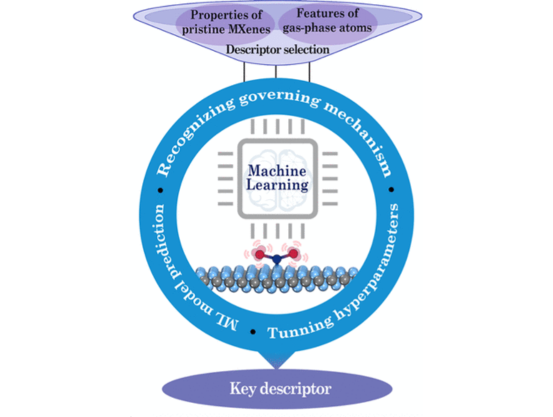
Abstract: The impact of divalent cations on the interfacial and structural properties of the vapor–liquid water interface covered with an anionic surfactant such as sodium dodecyl sulfate (SDS) is of great relevance to several industrial applications. In the present work, all-atom molecular dynamics simulations are performed to investigate the interfacial and structural properties of the vapor-SDS-liquid water interface with divalent salts viz., CaCl2 and MgCl2. The surface tension rises with the rise in divalent salt concentration, whereas it remains almost constant with NaCl concentration. In the absence of divalent salts, the accumulation of Na+ ions near the SDS headgroups is observed. Conversely, in the systems with divalent salts, the divalent cations (Ca2+ and Mg2+) enriched beside the SDS monolayer cause the monovalent cations (Na+) to displace from the interface into the bulk. The structural analysis shows that Na+ and Ca2+ cations enter the first hydration shell of the sulfate group of SDS. On the other hand, Mg2+ usually coordinates with the sulfate group of SDS. The potential of mean force (PMF) shows that the escape free energy of divalent cations is higher than monovalent cations, and the interaction between the cations and sulfate head group of SDS follows the order: S-Ca2+ > S-Mg2+ > S-Na+.
Read More ...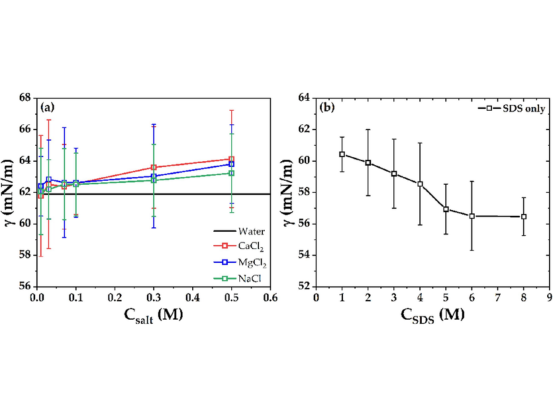
Abstract: Two-dimensional materials supported by single atom catalysis (SAC) is foreseen to replace platinum for large-scale industrial scalability of sustainable hydrogen generation. Here, a series of metal (Al, Sc, Ti, V, Cr, Mn, Fe, Ni, Cu, Zn) and nonmetal (B, C, N, O, F, Si, P, S, Cl) single atoms embedded on various active sites of graphitic carbon nitride (g-C3N4) are screened by density functional theory (DFT) calculations and six machine learning (ML) algorithms (support vector regression, gradient boosting regression, random forest regression, AdaBoost regression, multilayer perceptron regression, ridge regression). Our results based on formation energy, Gibbs free energy, and bandgap analysis demonstrate that the single atoms of B, Mn, and Co anchored on g-C3N4 can serve as highly efficient active sites for hydrogen production. The ML model based on support vector regression (SVR) exhibits the best performance to accurately and rapidly predict the Gibbs free energy of hydrogen adsorption (ΔGH) with a lower mean absolute error (MAE) and a high coefficient of determination (R2) of 0.08 eV and 0.95, respectively. Feature selection based on the SVR model highlights the top five primary features: formation energy, bond length, boiling point, melting point, and valence electron as key descriptors. Overall, the multistep workflow employed through DFT calculations combined with ML models for efficient screening of potential candidates for hydrogen evolution reaction (HER) from g-C3N4-based single atom catalysis can significantly contribute to the catalyst design and fabrication.
Read More ...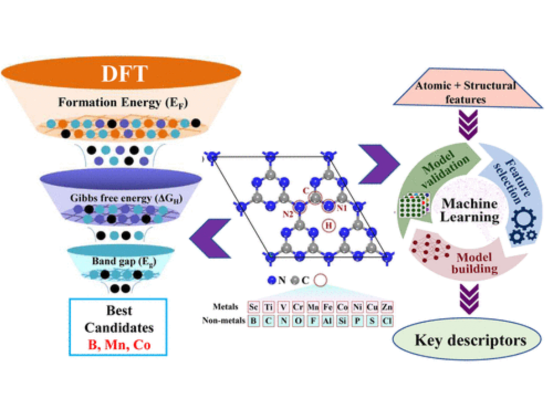
Abstract: Mutations in PINK1 kinase are known to be responsible for the early-onset of Parkinson's disease. The protein resides on the outer-membrane of healthy mitochondria, and acts as a quality controller by regulating and maintaining dysfunctional mitochondria also known as mitophagy. Limited knowledge of the mechanism of protein has made it cumbersome to elucidate an effective treatment. In this paper, we screen a set of kinase inhibitors using high-throughput screening for investigating potential activators. We have for the first time shown the plausible binding and selectivity towards the kinase inhibitors in the mutant PINK1 binding site. We also could highlight the ligand bind/unbinding pathway identifying the most stable binding pose utilizing the residues from the P-loop and DFG motif for drugs Tepotinib and Pyrotinib. Interestingly, no direct interaction of mutated residues with the ligand molecules were observed. Furthermore, we highlight that the Ins3 region and SER228 of the N-lobe display distinct conformational states that are inline with crystal structure for substrate binding specificity. Collectively, our findings provide a molecular basis for the PINK1 potential kinase activator, which would further facilitate as a starting point to probe new therapeutics by using the structure based drug designing for treating neurological disorder.
Read More ...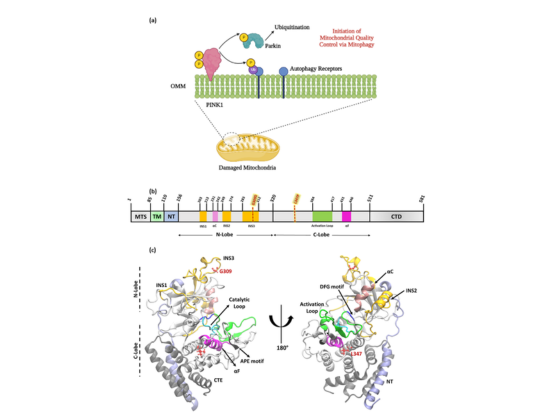
Abstract:The trans isomer of azobenzene (AB) and its derivatives is the most abundant isomer at thermodynamic equilibrium and is known to switch between its trans and cis isomers when triggered by light, electrons/holes and electrical field in adlayers on surfaces. However, the equilibrium initial condition limits the operation of molecular switches on surface due to large activation barrier for switching (trans to cis), hence the switching probability is very low. We show in this article, condensation of meta-stable (non-equilibrium) cis state of azobenzene derivatives on graphite. When electrons/holes induced switching is performed on these molecular switches from the meta-stable initial condition, the switching probability is enhanced by several folds. The molecules are switching between two associated cis states, instead of trans–cis switching. The switching between the cis states has relatively low energy barrier as revealed by density functional theory (DFT) calculations is at the origin of the enhanced switching probability. We also observe that reversible trans–cis and cis–cis’ switching on graphite is mediated through a stable charged intermediate state, leading to a low threshold voltage for switching compared to neutral molecules.
Read More ...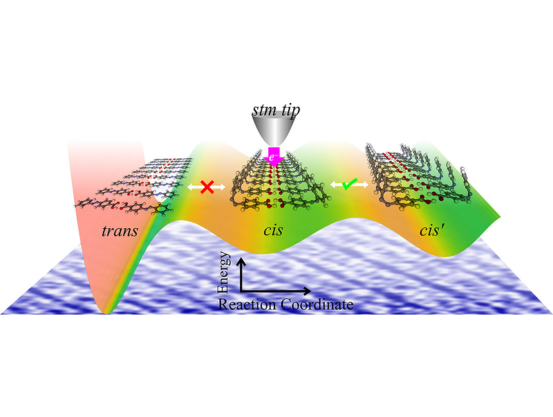
Abstract:This work investigates the freezing-induced self-assembly (FISA) of polyvinyl alcohol (PVA) and PVA-like polymers using molecular dynamics simulations. In particular, the effect of the degree of supercooling, degree of polymerization, polymer type, and initial local concentration on the FISA was studied. It was found that the preeminent factor responsible for FISA is not the diffusion of the polymers away from the nucleating ice front, but the increase in the polymer's local concentration upon freezing of the solvent (water). At a higher degree of supercooling, the polymers are engulfed by the growing ice front, impeding their diffusion into the supercooled solution and finally inhibiting their self-assembly. Conversely, at a relatively lower degree of supercooling, the rate of diffusion of the polymers into the supercooled solution is higher, which increases their local concentration and results in FISA. FISA was also observed to depend on the polymer–solvent interactions. Strongly favorable solute–solvent interactions hinder the self-assembly, whereas unfavorable solute–solvent interactions promote the self-assembly. The polymer and aggregate morphology were investigated using the radius of gyration, end-to-end distance, and asphericity analysis. This study brings molecular insights into the quintessential factors governing self-assembly via freezing of the solvent, which is a novel self-assembly technique especially suitable for biomedical applications.
Read More ...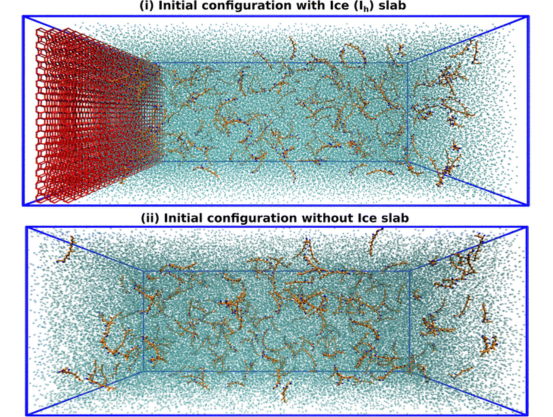
Abstract:A Zn(II)-based metal–organic framework (MOF) was synthesized by the self-assembly of the dicarboxylate ligand terephthalic acid (TPA), 2-aminoterephthalic acid (NH2-TPA) and N-donor auxiliary ligand 1,4-bis(4-pyridinylmethyl)piperazine (bpmp) using Zn(NO3)2·6H2O under hydrothermal conditions. {[Zn(TPA)0.5(NH2TPA)0.5(bpmp)]·DMF·7H2O}n (framework 1) has an sra topology with a BET surface area of 756 m2 g−1. The microporous nature of the framework is apparent from the significant CO2 adsorption capacities observed at various temperatures: 57 cc g−1 at 283 K, 46 cc g−1 at 293 K, 37 cc g−1 at 303 K, and 30 cc g−1 at 313 K. The considerable CO2 adsorption may be caused by the existence of free carboxylate and amine substituents that interact with the gas molecules and micropores. At room temperature, the activated MOF readily converts CO2 into cyclic carbonates when a suspension of the MOF is bubbled with ambient air and different epoxides under solvent-free conditions. The amine groups located within the pores of the MOF interact with CO2 molecules, enhancing their sorption and conversion to cyclic carbonates. However, due to interpenetration within framework 1, only smaller size epoxides can be accommodated and converted to cyclic carbonates in good yields. Additionally, the effectiveness of the catalyst is further confirmed by the positive outcomes obtained from the hot filtration control test. Grand canonical Monte Carlo (GCMC) molecular simulations were utilized to gain a better understanding of molecular interactions. GCMC results are in line with the experiments. The substantial adsorption of CO2 can be ascribed to the strong intermolecular interactions that occur between the amine groups within the framework and the CO2 molecules.
Read More ...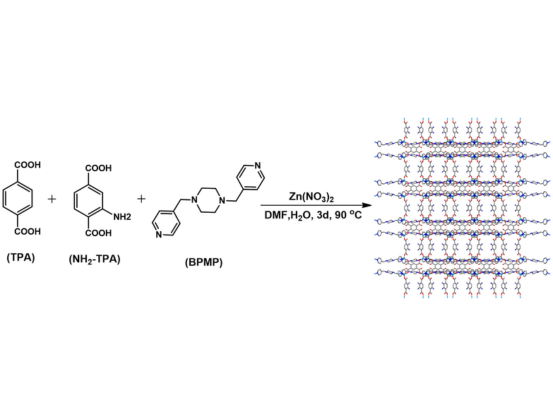
Abstract:Understanding the nucleation of homogeneous flow systems at high pressures is vital in protein crystallization and cryopreservation, where high pressure prevents the freezing of biological samples. This study examines the behavior of ice nucleation under shear at various pressures and explores the universal nucleation behavior of the sheared systems applied to supercooled water at higher pressures. In this study, the nucleation rates for the TIP4P/Ice model via a seeding method based on extended classical nucleation theory (CNT) are computed at pressures of 1, 100, 500, 700, and 1000 bar and a constant temperature of 240 K. Using extended CNT with explicitly embodying the shear rate, we analyzed the dependence of pressure on the transport and thermodynamic properties. In line with previous studies, we observed that Δμliq–ice and viscosity decrease while diffusivity increases with an increase in pressure. Furthermore, we showed that the dependence of the nucleation rate on shear at higher pressure is non-monotonic, with the maximum at optimal shear rates between 107 and 108 s−1. Our results demonstrate a non-monotonic pressure dependence of the optimal shear rates, which could originate from a violation of the Stokes–Einstein relation.
Read More ...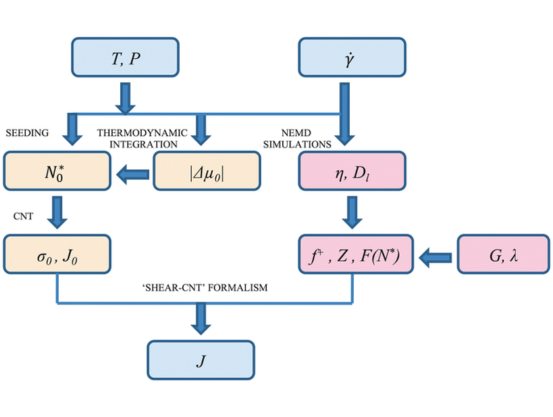
Abstract:We examine the linear stability of the gravity-driven flow of a viscoelastic fluid film down an inclined plane. The viscoelastic fluid is modeled using the Oldroyd-B constitutive equation and, therefore, exhibits a constant shear viscosity and a positive first normal stress difference in viscometric shearing flows; the latter class of flows includes the aforesaid film-flow configuration. We show that the film-flow configuration is susceptible to two distinct purely elastic instabilities in the inertialess limit. The first instability owes its origin entirely to the existence of a free surface and has been examined earlier [Shaqfeh et al., “The stability of gravity driven viscoelastic film-flow at low to moderate Reynolds number,” J. Non-Newtonian Fluid Mech. 31, 87–113 (1989)]. The second one is the analog of the centermode instability recently discovered in plane Poiseuille flow [Khalid et al., “Continuous pathway between the elasto-inertial and elastic turbulent states in viscoelastic channel flow,” Phys. Rev. Lett. 127, 134502 (2021)] and owes its origin to the base-state shear; it is an example of a purely elastic instability of shearing flows with rectilinear streamlines. One may draw an analogy of the aforesaid pair of unstable elastic modes with the inertial free-surface and shear-driven instabilities known for the analogous flow configuration of a Newtonian fluid. While surface tension has the expected stabilizing effect on the Newtonian and elastic free-surface modes, its effect on the corresponding shear modes is, surprisingly, more complicated. For both the Newtonian shear mode and the elastic centermode, surface tension plays a dual role, with there being parameter regimes where it acts as a stabilizing and destabilizing influence. While the Newtonian shear mode remains unstable in the limit of vanishing surface tension, the elastic centermode becomes unstable only when the appropriate non-dimensional surface tension parameter exceeds a threshold. In the limit of surface tension being infinitely dominant, the free-surface boundary conditions for the film-flow configuration reduce to the centerline symmetry conditions satisfied by the elastic centermode in plane Poiseuille flow. As a result, the regime of instability of the film-flow centermode becomes identical to that of the original channel-flow centermode. At intermediate values of the surface tension parameter, however, there exist regimes where the film-flow centermode is unstable even when its channel-flow counterpart is stable. We end with a discussion of the added role of inertia on the aforementioned elastic instabilities.
Read More ...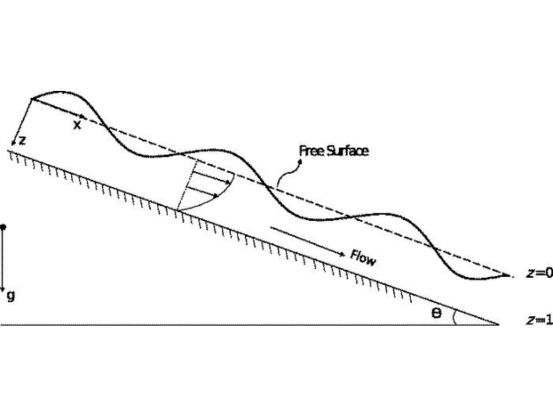
Abstract:Carrageenans comprise linear sulfated high molecular weight polysaccharides obtained from seaweeds and are routinely used in food and home/personal care industries. Various kinds of carrageenans differ from others based on the ester sulfate group location on the polysaccharide chains. Pure and mixed systems of Kappa Carrageenan and Iota Carrageenan undergo a three-dimensional gel network structure formation or dissociation with a change in temperature. During the sol-gel and gel-sol transitions, the Carrageenan systems pass through a unique critical gel state, where dynamic moduli are scale-invariant owing to the self-similar structure of the three-dimensional network. In this work, we obtain the critical gel state associated with pure and mixed systems of Kappa and Iota Carrageenan during cooling and heating by exploring the material behavior for a range of frequencies. Interestingly, on the one hand, the mixed gels show a higher critical sol-gel transition temperature compared to the pure systems at equal individual concentrations. On the other hand, the low temperature moduli of mixed gels are closer to that of Kappa Carrageenan when the concentration of the same is more than half in the mixture. The rheological measurements demonstrate that the Kappa Carrageenan strongly affects the nature of aggregation of double helices of Iota Carrageenan, but Iota Carrageenan does not have a significant influence on that of Kappa Carrageenan. These results suggest an associative, interactive network formation between Kappa and Iota Carrageenan in the mixture, such that the gel behavior is predominantly influenced by Kappa Carrageenan.
Read More ...
Abstract:Concepts in interface science apply to a plethora of use cases in various subfields of chemistry, physics, biology, and engineering. Changing interests in applications over time, such as toward efficient energy conversion and biomedical technology, create opportunities to connect the dots across less obviously related contributions and identify specific topics that advance interface science and engineering. Building on common aspects of molecular recognition, adsorption, assembly, and characterization of functionality in diverse areas, we plan to classify ideas and individual contributions into research topics in Virtual Special Issues. The Virtual Special Issues aim to position the journal Langmuir at the forefront of identifying trends in chemical interface science and engineering as well as to better serve and expand our readership in academia, industry, and government organizations (Figure 1a).
Read More ...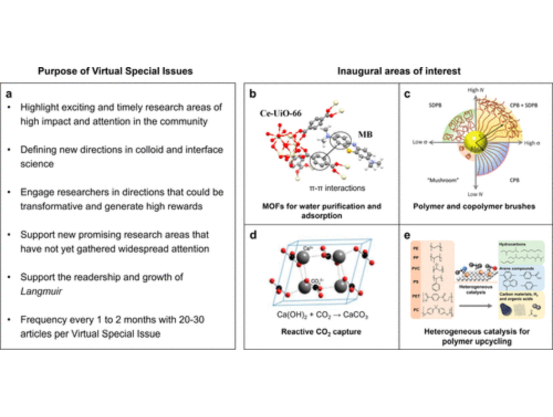
Abstract:The antineutrophil cytoplasmic antibody (ANCA)-associated vasculitides (AAV) are three discrete entities – Granulomatosis with polyangiitis (GPA), Microscopic polyangiitis (MPA), and Eosinophilic granulomatosis with polyangiitis (EGPA). They present with a plethora of signs and symptoms resulting in significant burden of mortality and morbidity. There is huge lacuna in the knowledge of relationship between various genes affecting pharmacogenetics of AAV and its implications in context of therapeutic complications. We thus intend to evaluate genotypic polymorphism in FcγR family & CYP genes affecting pharmaco-biological response of Rituximab and Cyclophosphamide respectively in AAV patients undergoing induction treatment.
Read More ...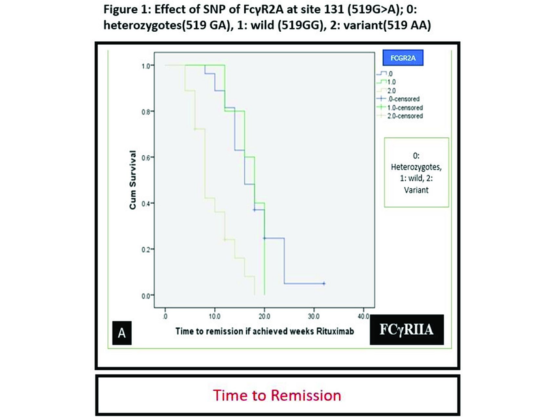
Abstract:A comprehensive understanding of the physics of electrowetting of a surfactant-laden droplet is important for applications in rapid healthcare diagnostics. A majority of biological samples examined during point-of-care (POC) diagnostics are biofluids with dissolved surfactants, such as the respiratory droplets containing protein (mucin) and surfactant molecules like dipalmitoylphosphatidylcholine. The presence of these surfactant molecules is anticipated to have a significant impact on the performance of electrowetting-based POC diagnostic devices. A reduced-order model is developed using the weighted residual integral boundary layer theory for the electrowetting of a surfactant-laden sessile droplet in a parallel plate electrode configuration. Thin film evolution equations are obtained for the fluid–fluid interface, the surfactant concentration, the depth-integrated flow rate, and the interfacial charge density. We show that the presence of surfactants opposes and decreases the strength of the electrohydrodynamic flow due to Marangoni stress-driven convection. The droplet then responds to an AC field with a suppressed amplitude of oscillation and the same mean deformation as that under DC forcing. Thus, low-frequency AC forcing with a suitable surfactant can plausibly be employed as a viable alternative to more energy-intensive high-frequency AC forcing.
Read More ...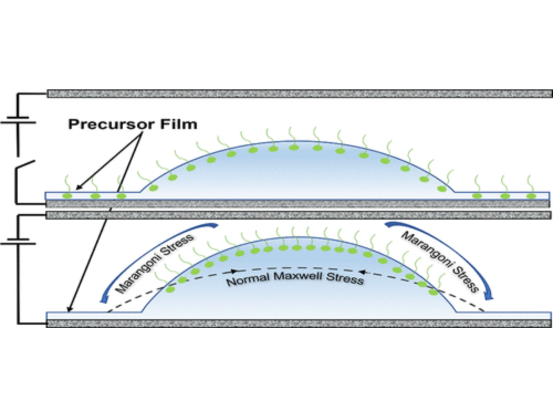
Abstract:The electrowetting behavior of a charge-carrying sessile droplet is relevant to applications such as point-of-care diagnostics. Often biomedical assays involve droplets that contain charged molecules such as dissolved ions, proteins, and DNA. In this work, we develop a reduced-order electrokinetic model for electrowetting of such a charge-carrying droplet under a parallel-plate electrode configuration. An inertial-lubrication model based on the weighted residual integral boundary layer (WRIBL) technique is used to obtain evolution equations that describe the spatiotemporal evolution of the fluid–air interface and the depth-integrated flow rate. The solutions to the evolution equations are obtained numerically by using the spectral collocation method. We investigate the role of domain and surface charges, characterized by the Debye length, on droplet wetting. Under low relaxation timescales, both droplet deformation and wetting alteration under an AC field are shown to be equivalent to that under a root-mean-square (RMS) DC field. We show that an electrolytic sessile droplet can exhibit a larger deformation in comparison to the two asymptotic limits of a perfect conductor and a perfect dielectric droplet, corresponding, respectively, to very low and high Debye lengths. The effects of several other parameters such as the inherent equilibrium wettability, permittivity ratio, and electric field strength are also investigated.
Read More ...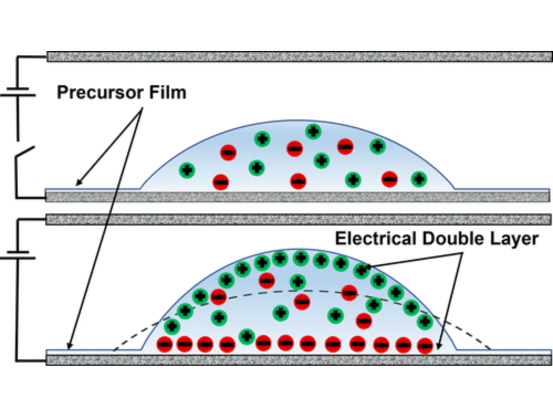
Abstract:Flue gas reforming of methane (FGRM), which involves the cofeeding of methane to an existing industrial flue gas stream, is an effective route to convert flue gas into syngas. Here, we perform the FGRM reaction over a freshly prepared Ni/γ-Al2O3 catalyst and simultaneously develop a microkinetic model using an existing methane reforming reaction mechanism applicable for the Ni catalyst. Experiments and simulations are carried out using methane and synthetic flue gas from coal-fired or natural gas-fired burners over a range of contact times (0.04–0.33 gcat h/g molreactants) and temperatures (600–700 °C). The parity plots reveal that the model can closely predict the experimentally observed values (R2 ≥ 97). With an increase in contact time, the conversion of reactants (CH4, CO2, and H2O) and yield of products (H2 and CO) gradually increase, whereas the H2/CO molar ratio rapidly decreases and approaches a constant value at high contact times. Moreover, conversions and yields also increase with an increase in the reaction temperature. The experimental and simulation data show that the excess water in flue gas from natural gas-fired burners results in lower CO2 conversions and higher H2/CO ratios. However, the CH4 conversion and H2 and CO yields remained unaffected. No evidence of coke deposition is seen on the spent catalyst surface, even at low contact times and a reaction temperature of 600 °C. To further explain the trends observed during the FGRM reaction, the variation of surface species coverage with contact time and temperature is also examined.
Read More ...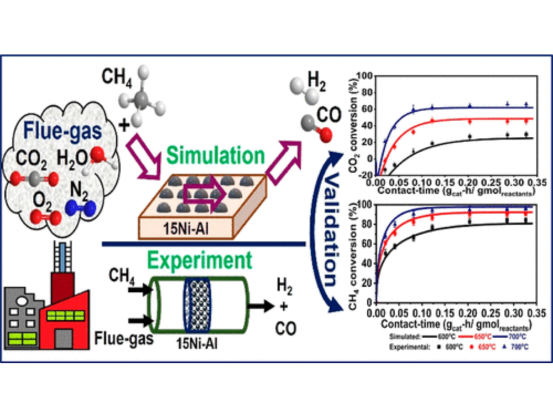
Abstract:Dry reforming of methane (DRM) and its modification with O2 co-feed, the ODRM reaction, have been gaining importance. However, a general rate equation applicable for the ODRM reaction with varying O2 co-feed has not been reported. This general rate equation should be applicable for the DRM and ODRM reactions depending on the amount of O2 co-feed. Microkinetic models simulate catalytic reactions without making any a priori assumptions for the RDS and are helpful in developing rate equations. Unfortunately, microkinetic modelling for ODRM over supported monometallic Ni has not been carried out. Here, we perform microkinetic modelling using an existing reforming reaction mechanism for ODRM over an alumina-supported Ni catalyst. Validation is achieved by comparing experimental and microkinetic outlet flow rates at different feed rates of O2 and applying R2 analysis and F-tests. Once the model is validated, we identify the RDS through a hierarchical strategy using microkinetic results and sensitivity analysis for varying amounts of O2 co-feed. The results reveal that CH4 activation is the RDS. CH4 activation can occur through direct dehydrogenation on an empty site or oxidative dehydrogenation aided by adsorbed O, depending on the amount of O2 co-feed. Once the RDSs are identified, we derive a general rate equation that effectively simulates the DRM reaction with different amounts of O2 co-feed. We further examine the effect of the amounts of O2 co-feed and ascertain the presence of maximum hydrogen production for certain amounts of O2 co-feed.
Read More ...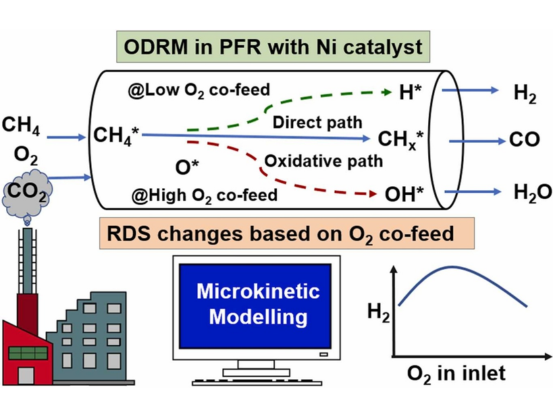
Abstract:Replacing nickel with iron is known to promote supported nickel catalyst for CO2 methanation. This promotion is often attributed to the presence of Ni-Fe alloy. However, the effect of replacing Ni with Fe on a common rate expression of CO2 methanation and the specific causes leading to the promotion are not addressed. To achieve these objectives, we synthesize and characterize an alumina supported Ni, 15NiAl, and two alumina supported Ni-Fe catalysts, 15Ni7FeAl and 15Ni3FeAl. These catalysts contain 15 wt% of Ni or Ni + Fe. In 15Ni7FeAl and 15Ni3FeAl the Ni/Fe ratio = 7 and 3, respectively. Characterization studies reveal the presence of smaller Ni-Fe alloy particles in the reduced and spent 15Ni7FeAl and 15Ni3FeAl catalysts. Other characteristics of the catalysts are also identified. With these catalysts we carry out the CO2 methanation reaction under different operating conditions. The enhancement in rate of CH4 formation, rCH4 , while using the two bimetallic supported catalysts strongly depends on the Ni/Fe ratio, reactant partial pressures and temperatures. We modify an existing rate expression to adequately represent the reaction data of the three catalysts. In this rate expression, the surface reaction between molecularly adsorbed reactant gases is the rate-determining-step. As Ni is progressively replaced with Fe in the bimetallic catalysts, the apparent rate constants and equilibrium constants for the adsorption of CO2 and H2 of the rate expression increases, which increases rCH4 . Under all operating conditions the 15Ni3FeAl catalyst shows the best rCH4 and the apparent rate constants and equilibrium constants are the largest. It appears that the Ni-Fe alloy increases the number of adsorption-sites and the fractional coverage of adsorbed CO2 and H2, which then results in enhanced rCH4 values.
Read More ...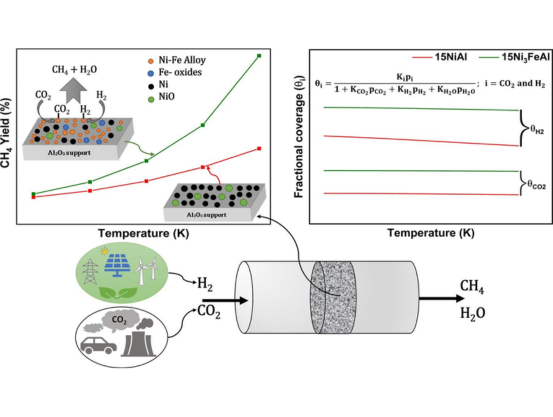
Abstract:Mesoporous Ni–Al2O3 catalysts with Ni weight (%) 5 to 15 were synthesized, characterized, and tested for tri-reforming of methane (TRM). The characterization results reveal that the metal loading influences the metal-support interaction of the catalysts. Furthermore, the choice of reduction temperature affected the dispersion of metallic-Ni. It is advantageous to reduce these catalysts at their respective temperatures, which are obtained from H2-TPR studies. At these conditions, the dispersion was maximum. For TRM at 600 °C, the conversions and yields increased with an increase in Ni loading, and carbon was not detected. Increasing the metal loading from 5 wt% to 15 wt% increased the CH4 conversion from 70.5 to 82.4% and CO2 conversion from 10.2 to 19.7%. In contrast, the H2/CO ratio decreased from 3.8 to 3.2. The conversions and yields during TRM were relatively constant with time-on-stream and were highest for 15Ni–Al. Furthermore, H2/CO ratio was >3, and minimal change in dispersion was observed post-reaction for this catalyst. Thus, the active metal loading and the reduction temperature required are important parameters that need to be considered while designing a suitable catalyst for TRM.
Read More ...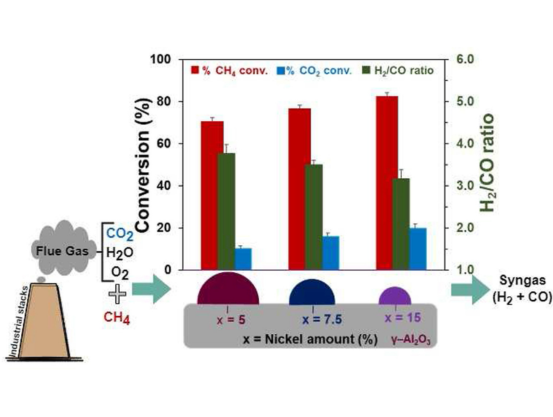
Abstract:The formation of NixSy/CoxSy phases on the HDS catalyst surface during catalyst preparation poses the following challenges in the HDS reaction: (1) inactive in the reaction, (2) hinder the role of promoters, (3) block the actives sites (NiMoS/CoMoS) at the perimeter, and (4) increase the inert mass on the catalyst surface. Since the formation of NixSy/CoxSy phases is thermodynamically favorable, it is difficult to control this during the catalyst synthesis. In this regard, this work investigates the effect of metal-support interactions and catalyst compositions on NixSy phase separation and removal of NixSy phases from the catalyst surface using acid-leaching method. The HDS activity for NiMo supported on amorphous alumina (NiMo/A-Al2O3) catalysts significantly increased after the acid-leaching treatment by unblocking the active NiMoS sites and increasing the Ni-MoS2 interaction through alumina support leaching. Overall, the HDS activity for leached NiMo/A-Al2O3 catalysts is 25–30% higher than that for conventional NiMo/γ-Al2O3 catalysts.
Read More ...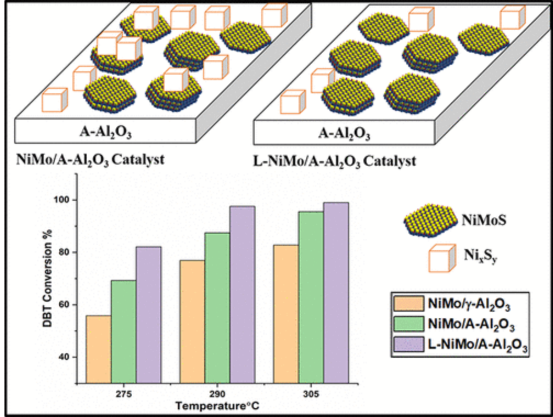
Abstract:Microswimmer suspensions in Newtonian fluids exhibit unusual macroscale properties, such as a superfluidic behavior, which can be harnessed to perform work at microscopic scales. Since most biological fluids are non-Newtonian, here we study the rheology of a microswimmer suspension in a weakly viscoelastic shear flow. At the individual level, we find that the viscoelastic stresses generated by activity substantially modify the Jeffery orbits well-known from Newtonian fluids. The orientational dynamics depends on the swimmer type; especially pushers can resist flow-induced rotation and align at an angle with the flow. To analyze its impact on bulk rheology, we study a dilute microswimmer suspension in the presence of random tumbling and rotational diffusion. Strikingly, swimmer activity and its elastic response in polymeric fluids alter the orientational distribution and substantially amplify the swimmer-induced viscosity. This suggests that pusher suspensions reach the superfluidic regime at lower volume fractions compared to a Newtonian fluid with identical viscosity.
Read More ...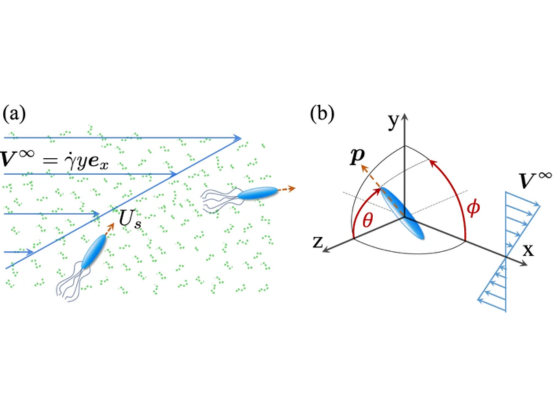
Abstract:In Newtonian fluids, microswimmers need to perform a non-reciprocal shape change to move forward. However, this is no longer required in biological fluids with their viscoelastic properties. In this work, we investigate an oscillating two-sphere swimmer in a weakly viscoelastic fluid and show that the swimmer moves toward the smaller sphere. We use the flow fields generated by the individual spheres. Since they contain a viscoelastic contribution quadratic in the sphere velocities, the forces needed to expand and contract the swimmer differ from each other. This causes a non-zero net displacement during one cycle. We also find that the mean flow field generated by the two-sphere swimmer is the one of a contractile force dipole.
Read More ...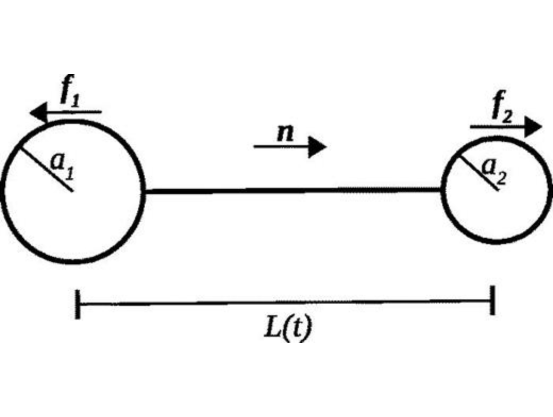
Abstract:Carbon capture, utilization, and storage techniques are required to address concerns related to global warming resulting from the rising atmospheric CO2 concentration. Currently, amine-based solvents are commonly used for post-combustion CO2 capture. The amine-based (liquid) sorption technology has numerous disadvantages including the perilous by-products and a high-energy prerequisite for their regeneration. Thus, extensive research is ongoing worldwide to develop cost-effective, sustainable, environmentally friendly, and effective sorbents for post-combustion CO2 capture. The distinctive features of clay-based materials make them particularly promising for CO2 adsorption. This critical review explores the current technology, adsorbents, and challenges associated with CO2 capture and finding answers in exploring exfoliated clay-based adsorbents as porous, high-surface area, inexpensive, efficient, and compatible materials for CO2 capture. Specifically, the review narrates a summary of various procedures useful for clay exfoliation and discusses a variety of chemical, inorganic, and organic modifications for designing exfoliated clay-based nanocomposites for CO2 capture. Further, the review touches upon various practical ways to prepare exfoliated clay-based composites, as membranes, aerogels, and nanofluids, for CO2 capture.
Read More ...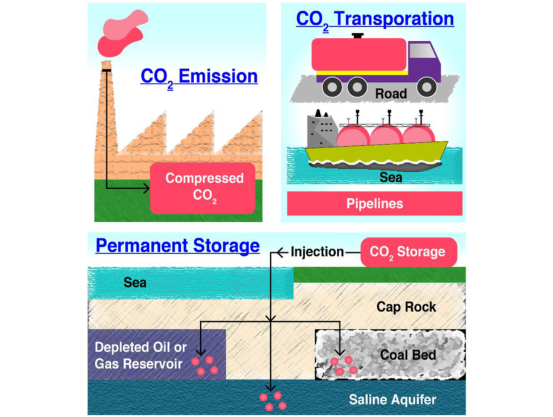
Abstract:This work uses a one-step KOH activation for lignin precursors to produce ultra-high mesoporous activated carbons (ACs) with an unprecedented combination of the surface area of 3207 m2 g−1 and mesopore ratio of 76%. The ACs are applied for supercapacitors (SCs) and methylene blue (MB) adsorption. The capacitance of the SCs in the three-electrode system reaches 812.3 F g−1 and demonstrates a remarkable maximum MB adsorption capacity of 1250 mg g−1. By modifying the process conditions, the mesopore ratio of ACs could be controlled from 10% to 80%. Compared with one-step activation, a two-step method produced microporous carbons with a lower surface area of 1227 m2 g−1 and a high micropore ratio of 73%. The capacitance of SCs with two-step ACs reached 228.1 F g−1 and the maximum adsorption capacity of 476.19 mg g−1 for MB adsorption. The two-step method limited the surface area but had a higher oxygen surface functionality, benefiting its electrochemical performance. A techno-economic analysis reveals that the one-step KOH activation-based process develops ACs with a minimum selling price of $7648/ton. This work demonstrates tuning the processing-structure-property-performance relationship of lignin-based ACs to make an economically viable domestic carbon source.
Read More ...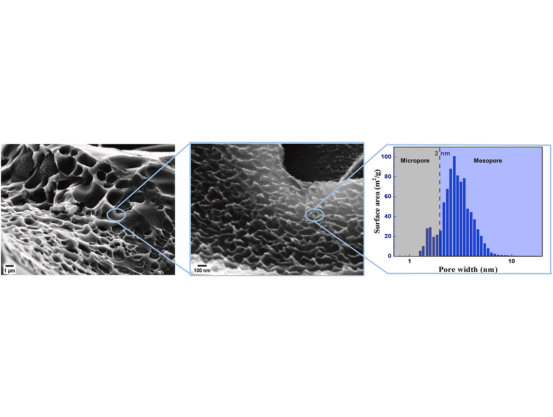
Abstract:Creating light-harvesting heterojunctions as a photocatalyst is critical for efficiently treating organics-laden wastewater. Yet the materials stabilization and limited reusability hinder their practical applications. In this study, an S-scheme heterojunction in the Sn-based perovskite and g-C3N4 (gCN) composite, supported on an activated carbon fiber (ACF) substrate, is developed for glyphosate (GLP) degradation under water under flow conditions. The reusable NiSnO3-gCN/ACF photocatalyst was synthesized using a simple wet impregnation and calcination method. The supported photocatalyst achieved 99% GLP-removal at 4 mL/min water flowrate and 1.25 g/m2 of photocatalyst loading in ACF. The photocatalyst showed a stable structure and repeat photocatalytic performance across 5 cycles despite prolonged visible light exposure under flow conditions. The materials stability is attributed to the effective dispersion of NiSnO3-gC3N4 in ACF, preventing the photocatalyst from elution in water flow. Radical trapping experiment revealed the superoxide and hydroxyl radicals as the primary reactive species in the GLP-degradation pathway. A plausible S-scheme mechanism was proposed for heterojunction formation, based on the high resolution deconvoluted spectra of X-ray photoelectron spectroscopy and the radical trapping experimental results. The inexpensive Sn-based perovskite synthesized in this study is indicated as an alternative to Ti-based perovskites for wastewater remediation application.
Read More ...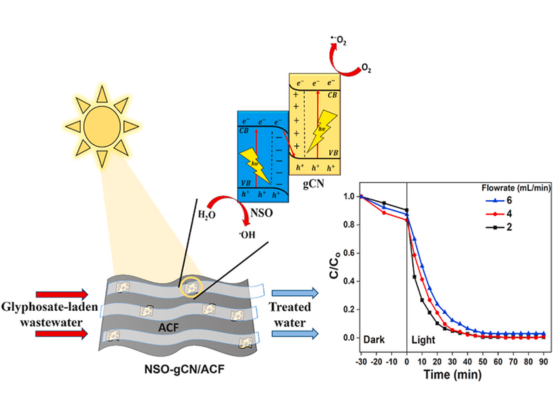
Abstract:A UV–Vis spectroelectrochemical sensor is fabricated for the selective detection of the bilirubin (BR) liver-biomarker. The novel CeO2-capped carbon nanofibers (CNFs) coated over an indium tin oxide substrate is used as the sensing electrode. CNFs are grown over CeO2 nanoparticles using acetylene as the carbon source. Measurements are based on the cyclic voltammetry coupled UV–Vis spectroscopy technique, where BR is electro-oxidized to purpurin that is detected at 316 nm in the absorbance spectra. A linear calibration plot (R2 > 0.99) is recorded over the BR concentration range of 5 – 200 µM in carbonate buffer at pH 10. The limit of detection of the sensor is determined as 4.49 µM. The CeO2-CNF improves the electrocatalytic activity and electroconductivity of the electrode, thereby decreasing the charge transfer resistance for BR oxidation. Owing to its dual selectivity, the hybrid SEC approach eliminates the interferences from uric acid, ascorbic acid, glucose, and the other quickly oxidized biomolecules. The sensor is successfully tested in biological samples.
Read More ...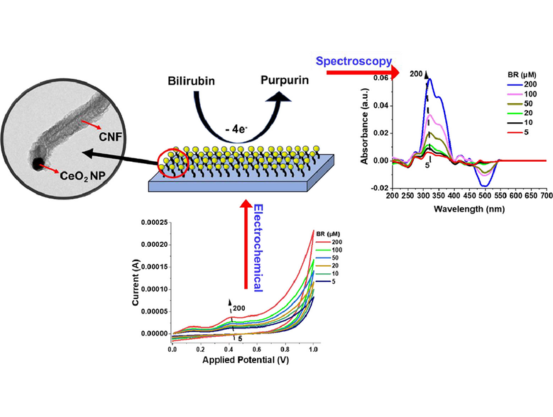
Abstract:A novel heterojunction between Sn-based perovskite and graphitic carbon nitride (gCN) is synthesized to achieve an enhanced spatial charge separation. The interfacial coupling between cube-shaped nickel tin oxide (NSO) and gCN is achieved through the surface sites in NSO. An improved hydrogen production rate of 646 µmol g−1 h−1 is measured in the composite (NSO-gCN), which is twice that in gCN, using triethanolamine (TEOA) and chloroplatinic acid (1% w/w) as holes scavenger and the precursor for the Pt cocatalyst, respectively. Such significant improvement in H2 production performance of the composite is benefited by the high reductive electrons generated via an S-scheme charge transfer pathway, as evidenced by radical trapping experiments and XPS elemental analysis. The composite shows good stability in hydrogen evolution, with marginal (3%) decrease measured in the materials activity after 5 cycles. This study provides an opportunity to develop an S-scheme heterojunction with the Sn-based perovskite anchored in gCN, as an alternative to Ti-based perovskite for various photocatalytic reactions.
Read More ...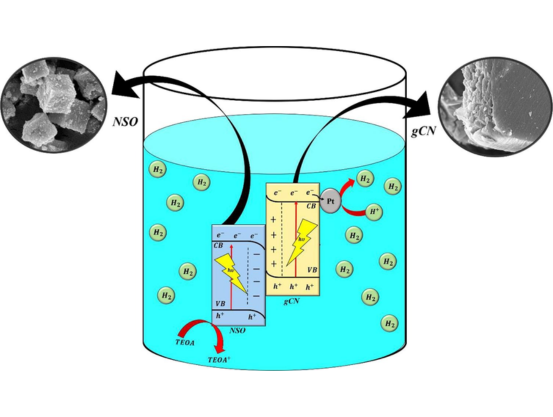
Abstract:A resorcinol-formaldehyde (RF)-based Janus membrane was fabricated by casting graphene oxide (GO)-dispersed RF solution on Janus-B side and Cu salt-RF solution on the opposite Janus-A side of an activated carbon fibre (ACF) substrate, and then subjecting the composite material to chemical vapor deposition to form a web of carbon nanofiber (CNF) on the Janus-A side. CNF imparted the super-hydrophobic (water contact angle WCA ∼151°) and super-oleophilic (oil contact angle OCA ∼0°) characteristics, while GO-RF imparted the hydrophilic (WCA 30°) and olephobic (OCA ∼121°) characteristics to the membrane. The microfiltration tests were carried out under different conditions of oil and water feed concentrations (0–15% v/v) and operating pressure (1–3 bar). The super-hydrophobic side showed 99.75% water rejection efficiency and the initial permeate flux of 1020 Lm−2h−1 for a 5% (v/v) water-in-oil (W/O) emulsion, while the hydrophilic side showed 99.96% oil rejection efficiency and the initial permeate flux of 380 Lm−2h−1 for 5% (v/v) oil-in-water (O/W) emulsion. The material showed good chemical stability in acidic, basic and corrosive media as well as an excellent repeatability under the repeated alternate cycles of pure diesel/water and emulsion post- simple ethanol wash. Considering that the method of fabrication is simple, fast, and scalable, the comparative performance data clearly pitch CNF-RF/ACF/GO-RF ahead of the other membranes discussed in the literature for oil-water emulsion.
Read More ...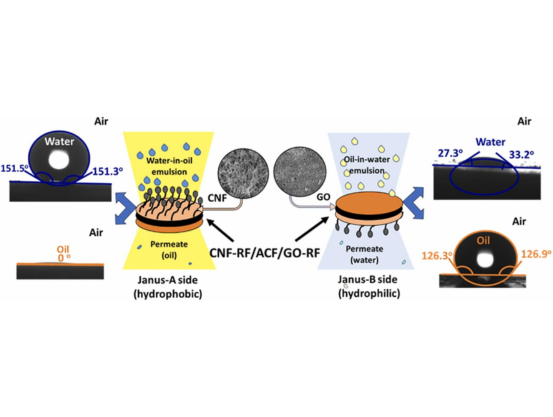
Abstract:This study presents an alternative to adsorptive desulphurization (ADS) process in packed beds by making use of enhanced radial mixing prevalent in coiled flow inverter (CFI). We describe the synthesis of Cu-tartrate as the precursor for Cu-carbon nanofiber (Cu-CNF) and the application thereof in ADS of liquid fuels in a CFI. Thiophene was removed from n-hexane using a slurry of Cu-CNF in the liquid. The data show the sulfur (S) - loading of 103 mg/g in Cu-CNF at 2000 ppmw-S concentration of thiophene in the liquid at 120 cc/min flowrate using five CFI units connected in series. Recycling was introduced for the first time in CFI, and three CFI units connected in series with the recycle ratio of 2 were sufficient to achieve the same removal efficiency as with five CFI without recycling. The results indicate that CFI is an efficient technology and has potential to replace packed bed adsorbers.
Read More ...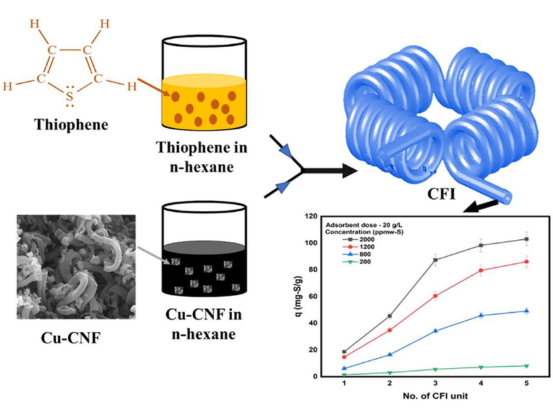
Abstract:Calcite particles coated with nano-silica find use in applications such as enhanced oil recovery, paper-making, and thermal energy storage. In this study, the surface coating of calcite particles by silica nanoparticles (nano-SiO2) in aqueous solutions assisted by a CO2 environment was investigated. The result indicates that the coating performance can be controlled by altering the electrostatic attraction between calcite and nano-SiO2, with the calcite surface charge being the predominant factor. An elevated CO2 partial pressure (up to 3.7 atm) is beneficial for the coating process. However, similar coating performance can be achieved under lower CO2 partial pressures by introducing calcium salt into the aqueous solution. With the addition of 15 wt% of nano-SiO2 in a 6.5 mM CaCl2 solution, a nano-SiO2 loading content of 12.6 wt% (with an average calcite particle size of 6.74 µm) was achieved under 1 atm CO2 pressure after 24 h of the coating experiment. Overall, the coating of calcite surfaces with high contents of well-dispersed nano-SiO2 can be achieved in a CO2 environment, and calcium salts can be used to reduce the required CO2 pressure. As such, it is potentially feasible to integrate wet coating into aqueous carbonation-based CO2 mineralization processes to enhance process economics by making nano-SiO2-coated calcite a valuable byproduct.
Read More ...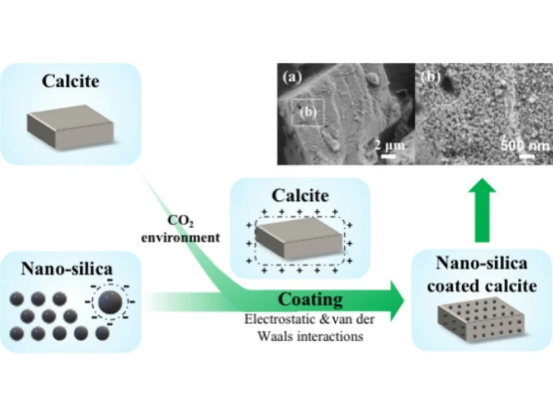
Abstract:Driven by the necessity to achieve a thorough comprehension of the bottom-up fabrication process of functional materials, this experimental study investigates the pair-wise interactions or collisions between chemically active SiO2-Pt Janus Colloids. These collisions are categorized based on the Janus colloids orientations before and after they make physical contact. In addition to the hydrodynamic interactions, the Janus colloids are also known to affect each others chemical field, resulting in chemophoretic interactions, which depend on the degree of surface anisotropy in reactivity and solute-surface interaction. These interactions lead to a noticeable decrease in particle speed and changes in orientation that correlate with the contact duration and yield different collision types. Our findings reveal distinct configurations of contact during collisions, whose mechanisms and likelihood is found to be dependent primarily on the chemical interactions. Such estimates of collision and their characterization in dilute suspensions shall have key impact in determining the arrangement and time scales of dynamical structures and assemblies of denser suspensions, and potentially the functional materials of the future.
Read More ...
Abstract:Typical bodily and environmental fluids encountered by biological swimmers consist of dissolved macromolecules such as proteins or polymers, rendering them even non-Newtonian at times. Active droplets mimic the essential propulsive characteristics of several biological swimmers, and serve as ideal model systems to widen our understanding of their locomotive strategies. Here, we investigate the motion of a micellar solubilization driven active oil droplet in an aqueous medium consisting of polymers as macromolecular solutes. Experiments reveal extreme sensitivity of the droplet motion to the presence of macromolecules in its ambient medium. Through in situ visualization of the self-generated chemical field around the droplet, we notice unexpectedly high diffusivity of the filled micelles in the presence of high molecular weight polymeric solutes. This highlights the breakdown of continuum approximation due to a significant size difference between the macromolecular solutes and the micelles. It is shown that the Péclet number, defined based on the experimentally determined filled micelle diffusivity (taking into account the local solvent viscosity) successfully captures the transition from smooth to jittery propulsion mode for both molecular and macromolecular solutes. With an increase in macromolecular solute concentration, particle image velocimetry reveals another mode switching from the conventional pusher mode to puller mode of propulsion, characterized by a more persistent droplet motion. By doping the ambient medium with suitable choice of macromolecules, our experiments unveil a novel route to orchestrate complex transitions in active droplet propulsion.
Read More ...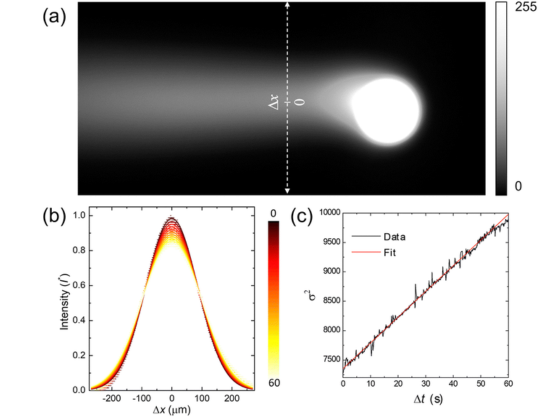
Abstract:In pursuit of a novel effective treatment for prostate cancer, methanolic extract of Stephania glabra tubers (Sg-ME) was utilized to fabricate silver (Sg-AgNP), copper oxide (Sg-CuONP), and silver-copper bimetallic nanoparticles (Sg-BNP). The characterization of the nanoparticles confirmed spherical shape with average diameters of 30.72, 32.19, and 25.59 nm of Sg-AgNP, Sg-CuONP, and Sg-BNP, respectively. Interestingly, these nanoparticles exhibited significant cytotoxicity toward the prostate cancer (PC3) cell line while being non-toxic toward normal cells. The nanoparticles were capable of inducing apoptosis in PC3 cells by enhancing reactive oxygen species (ROS) generation and mitochondrial depolarization. Furthermore, the shrinkage of 3D prostate tumor spheroids was observed after 4 days of treatment with these green nanoparticles. The 3D model system was less susceptible to nanoparticles as compared to the 2D model system. Sg-BNP showed the highest anticancer potential on 2D and 3D prostate cancer models.
Read More ...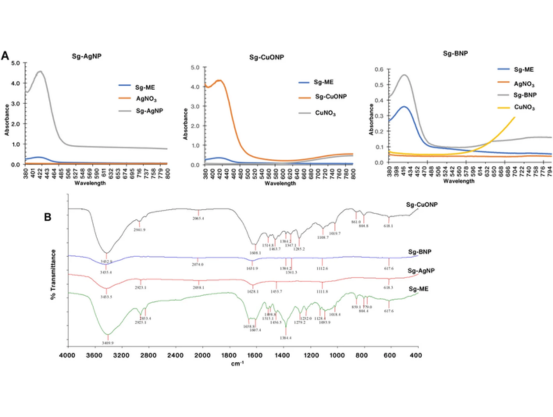
Abstract:The β-phase of the copolymer poly(vinylidene fluoride–trifluoroethylene) P(VDF–TrFE) possesses the highest dipole moment among all the functional polymers. It remains a key component of flexible energy-harvesting devices based on piezoelectricity and triboelectricity in the last decade. However, the quest for P(VDF–TrFE)-based magnetoelectric (ME) nanocomposites with enhanced ferroelectric, piezoelectric, and triboelectric properties remains elusive. The magnetostrictive inclusion in the copolymer matrix forms electrically conducting pathways and degrades β-phase crystallinity significantly, deteriorating the functional properties of the nanocomposite films. To address this issue, we report the synthesis of magnetite (Fe3O4) nanoparticles on micron-scale magnesium hydroxide [Mg(OH)2] templates. These hierarchical structures were incorporated within the P(VDF–TrFE) matrix rendering composites with enhanced energy-harvesting capability. The Mg(OH)2 template prevents the formation of a continuous network of magnetic fillers, leading to lower electrical leakage in the composite. The addition of dual-phase fillers with 5 wt % only increases remanent polarization (Pr) values by ∼44%, owing to the presence of the β-phase with significant crystallinity and increased interfacial polarization. The composite film exhibits a quasi-superparamagnetic nature and a significant magnetoelectric coupling coefficient (αME) of 30 mV/cm Oe. The film was also employed for triboelectric nanogenerator applications, exhibiting five times higher power density than the pristine film. We finally explored the integration of our ME devices with an internet of things platform to monitor the operational status of electrical appliances remotely. In light of these findings, the present work opens the path for future self-powered, multifunctional, and flexible ME devices with new application domains.
Read More ...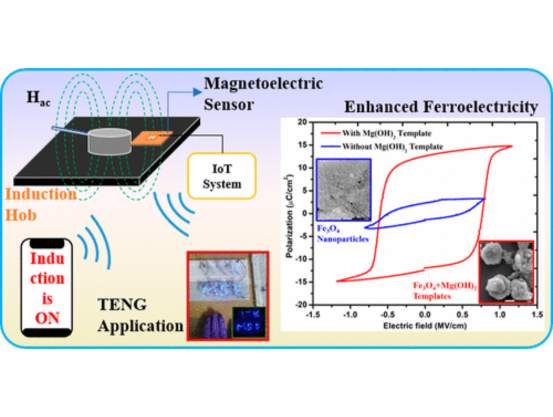
Abstract:The development of biosensors for the selective detection of Pb2+ and guanine is critical for the elucidation of lead toxicity and human health monitoring. In this research, blue-green luminous water-soluble nitrogen-doped graphene nanosheets (ws-NGNSs) were synthesized from biomass as an optical sensor for guanine and Pb2+ in aqueous media. A facile hydrothermal approach followed by mild oxidation was used for the synthesis of ws-NGNSs, where rotten pear was used as the carbon source and urea was used as the nitrogen source. The ws-NGNSs emitted intense fluorescence at a maximum excitation/emission wavelength of 340/425 nm. The addition of Pb2+ effectively quenched the blue-green emission of ws-NGNSs with prominent selectivity. The selectivity is attributed to the synergic effects of heteroatom doping, surface functional groups, and surface-active sites. Further, ws-NGNSs/Pb2+ was used as a promising fluorescent probe for the selective recognition of guanine. The addition of guanine induced the fluorescence “turn on” effect. Therefore, ws-NGNSs with excellent fluorescence properties can be used as efficient fluorescence “on-off-on” nano-switches for the selective detection and differentiation of Pb2+ and guanine with limits of detection of 8 μM and 0.2 μM, respectively. The possible sensing mechanism is explained using fluorescence and UV-vis spectroscopy. Water-soluble NGNSs have a solid foundation for the fabrication of optical sensors for biomedical and environmental applications.
Read More ...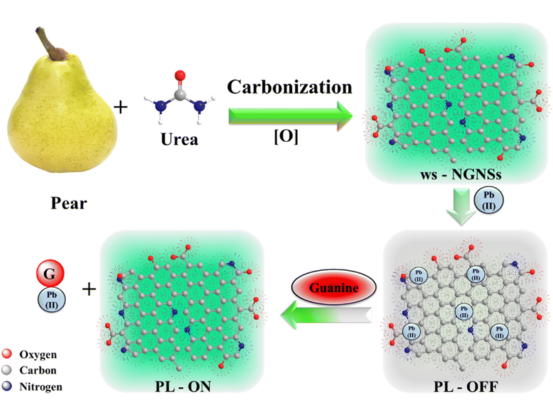
Abstract:Sweat-based wearable devices are attracting attention for non-invasive monitoring of various biomarkers present in sweat. However, the problem of inadequate sweat volume remains prevalent in sweat testing. To overcome this challenge, we present an integrated flexible platform that incorporates open microfluidic tracks, specifically designed for efficient sweat collection. The construction of these tracks involves employing a simple wettability patterning method using PDMS-TiO2 nanocomposite as a coating surface. Additionally, a thorough characterization study is conducted to analyze the synthesized composite material comprehensively. Furthermore, we propose a novel curvilinear wedge track design, inspired by the teeth structure of Nepenthes alata, to enhance droplet collection, achieving an improvement in collection efficiency in the range 86–94%. The physics of droplet transport is explained through simulations. To demonstrate the feasibility of our approach, we fabricated and tested a patch embedded with a wedge track and a screen printed three-electrode system, showcasing successful sweat collection. The novelty of this work lies in the development of a fabricated patch that minimizes sample volume requirements when integrated with the electrode system. Additionally, its orientation-independent design makes it suitable for wearable applications.
Read More ...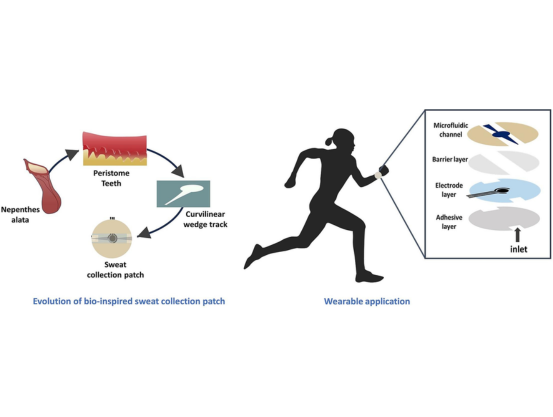
Abstract:Field effect transistor (FET) type gas sensors are suitable for various wearable and portable applications due to tuneable sensitivity, miniaturized structure, ease of integration, and low power consumption. However, semiconductors such as Si and IGZO did not show good sensing characteristics due to the chemical inertness of the analyte gases. PANI-based conductometric gas sensors have shown good gas sensing characteristics, yet the transfer characteristics for pristine PANI have not been reported due to their inherent conductivity. In this work, transfer characteristics of a PANI based p-FET gas sensor and modulation of gate voltage for tuning of the NH3 sensing characteristics are reported for the first time. Vertical nanofibers of PANI semiconductor grown on SiO2 substrate showed depletion mode transfer characteristics with Ion/Ioff ratio of 184, mobility of 0.051 cm2/V.s, threshold voltage of 39.3 V, and subthreshold swing of −1.46 V/dec. The threshold voltage of FET decreased upon exposure to NH3 gas, which confirmed deprotonation of the PANI nanofibers. Further, the NH3 sensitivity and detection limit were optimized by tuning the gate voltage at 20 V. The drain current of the FET type sensor was decreased by 41% upon exposure to 50 ppm NH3, and the sensor can detect NH3 concentrations as low as 2 ppm at a gate bias of 20 V. Response of the FET type sensor was found to be ∼20 times higher than the spin-coated conductometric gas sensor.
Read More ...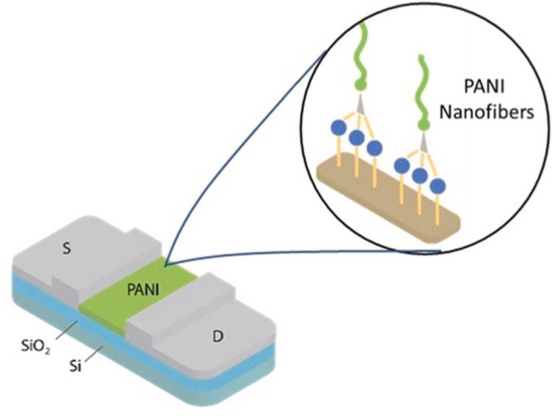
Abstract:PANI-metal oxide nanocomposites have been studied extensively to improve sensor performance at room temperature. To date, researchers have utilized PANI-TiO2 for sensing NH3, but no elucidation of the sensing mechanism has been reported. In this research work, PANI-TiO2 nanocomposite-based flexible gas sensor for detecting NH3, operating at room temperature, has been investigated. The novelty lies in elucidating the sensing mechanism using electrochemical impedance spectroscopy (EIS) study. Effects of the operating temperature and different humidity levels of the CDA environment on the sensing parameters of the devices are also studied. PANI-TiO2 (10 wt% TiO2 with respect to aniline) device showed the best response of 9.88% against 2 ppm of NH3 at 21 °C. The sensor can detect NH3 as low as 2 ppm within 10 seconds. A low deviation of 3.5% in sensor response after 100 bending cycles was observed. Further, the sensor maintained a near-consistent response even after seven months of fabrication. Moreover, linearity was observed in the I-V analysis, providing further evidence that devices are ohmic. Furthermore, the contributions of the bulk, grain boundary, depletion region, and resistance between the electrode and the sensing film in the sensor response were identified by the EIS studies.
Read More ...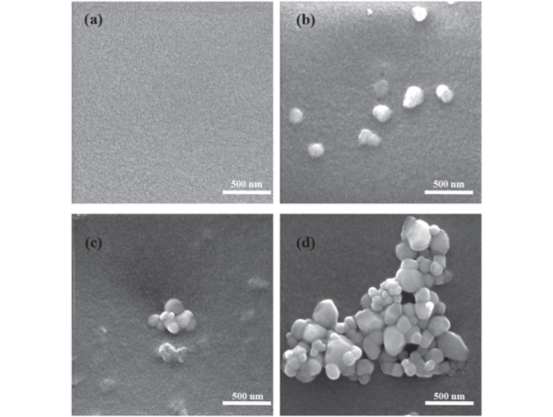
Abstract:Solitons in liquid crystals have generated considerable interest. Several hypotheses of varying complexity have been advanced to explain how they arise, but consensus has not emerged yet about the underlying forces responsible for their formation or their structure. In this work, we present a minimal model for solitons in achiral nematic liquid crystals, which reveals the key requirements needed to generate them in the absence of added charges. These include a surface inhomogeneity, consisting of an adsorbed particle capable of producing a twist, flexoelectricity, dielectric contrast, and an applied ac electric field that can couple to the director’s orientation. Our proposed model is based on a tensorial representation of a confined liquid crystal, and it predicts the formation of “butterfly” structures, quadrupolar in character, in regions of a slit channel where the director is twisted by the surface imperfection. As the applied electric field is increased, solitons (or “bullets”) become detached from the wings of the butterfly, and then propagate rapidly throughout the system. The main observations that emerge from the model, including the formation and structure of butterflies, bullets, and stripes, as well as the role of surface inhomogeneity and the strength of the applied field, are consistent with experimental findings presented here for nematic LCs confined between two chemically treated parallel plates.
Read More ...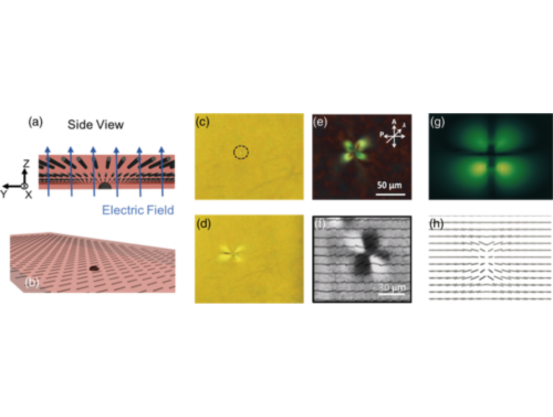
Abstract:Solitons are highly confined, propagating waves that arise from nonlinear feedback in natural (e.g., shallow and confined waters) and engineered systems (e.g., optical wave propagation in fibers). Solitons have recently been observed in thin films of liquid crystals (LCs) in the presence of ac electric fields, where localized LC director distortions arise and propagate due to flexoelectric polarization. Here we report that collisions between LC solitons and interfaces to isotropic fluids can generate a range of interfacial hydrodynamic phenomena. We find that single solitons can either generate single droplets or, alternatively, form jets of LC that subsequently break up into organized assemblies of droplets. We show that the influence of key parameters, such as electric field strength, LC film thickness, and LC-oil interfacial tension, map onto a universal state diagram that characterizes the transduction of soliton flexoelectric energy into droplet interfacial energy. Overall, we reveal that solitons in LCs can be used to focus the energy of nonlocalized electric fields to generate a new class of nonlinear electrohydrodynamic effects at fluid interfaces, including jetting and emulsification.
Read More ...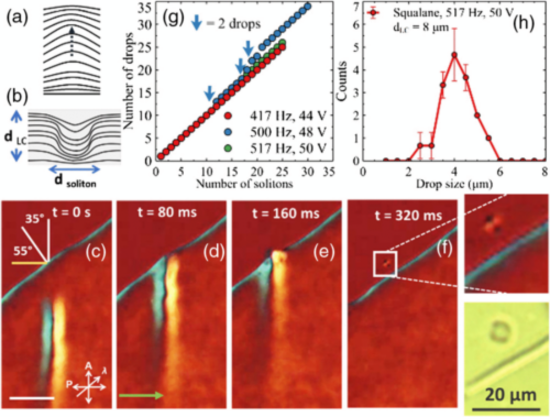
Abstract:Aldol condensation of furfural with acetone is an important biofuel upgrading reaction. Herein, we investigated the rate-controlling step of aldol condensation, i.e., the keto–enol tautomerization of acetone, in Sn-doped BEA (Sn-BEA) and hydrogen-compensated Al-doped BEA (H-BEA) zeolites. We also investigated the rate-enhancing role of molecular water at 373 K. In dehydrated H-BEA, we find that the reaction takes place concertedly with a free-energy barrier, which is ∼160 kJ/mol lower than the uncatalyzed gas-phase reaction. The barrier is further reduced in the presence of water, which provides an alternate path for proton transfer. Further, we find that defect-free Sn-BEA under dehydrated conditions is catalytically inactive for the tautomerization of acetone. In the presence of H2O, we modeled two different active sites: monohydrated closed Sn-site and an open Sn-site formed by partial hydrolysis of a closed Sn-site. We find that a monohydrated closed Sn-site is thermodynamically more stable than an open Sn-site. Our calculations suggest that both configurations have comparable activity toward keto–enol tautomerization of acetone and are much higher than a dehydrated closed Sn-site. Overall, our calculations suggest that the activity of BEA zeolite is enhanced in the presence of low concentrations of water, which acts as a cocatalyst. This is true for both Sn-doped and Al-doped BEA, and the effect is more dramatic in the Sn-doped BEA.
Read More ...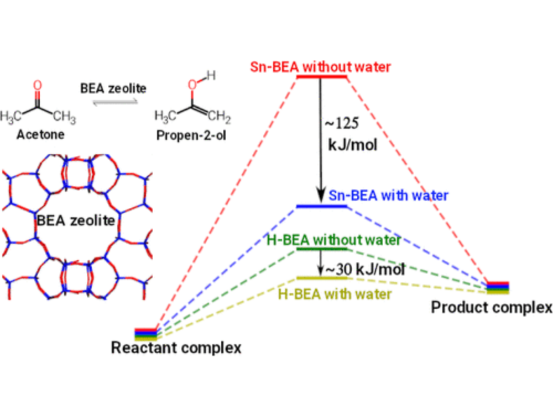
Abstract:Rate of a reaction is enhanced by increase in temperature, partial pressure or the concentration of reactants, and/or via use of a catalyst or an enzyme. Whereas the former increases the probability of collision rate between different molecules, the latter provides an alternate reaction path that diminishes the activation energy barrier for reaction, both effects increase the reaction rate. The deformability of the substrate on which a reaction occurs is not known to affect this rate. In contrast, by carrying out reduction of Gold and Silver salt on soft, crosslinked layers of poly(dimethylsiloxane) (PDMS), we show here that surface tension driven deformation of the solid too can increase the reaction rate. The PDMS contains SiH groups as organosilanes which reduces the salt thereby producing the corresponding metallic nano-particles. When an aqueous solution of the salt is dispensed as a sessile drop on a sufficiently soft PDMS layer, nano-particles get generated at ~3 times the rate over which when the salt solution is dispensed as a pool on the same surface. Unlike the pool, the drop has a three-phase contact line, where it pulls up the solid forming a ridge. By balancing the resultant surface stresses at the vicinity of this ridge, we have estimated the excess surface free energy associated with it. We show that this excess energy can diminish the activation energy barrier and increase the reaction rate to the extent that would have been achieved by increasing the reaction temperature by over 30o C.
Read More ...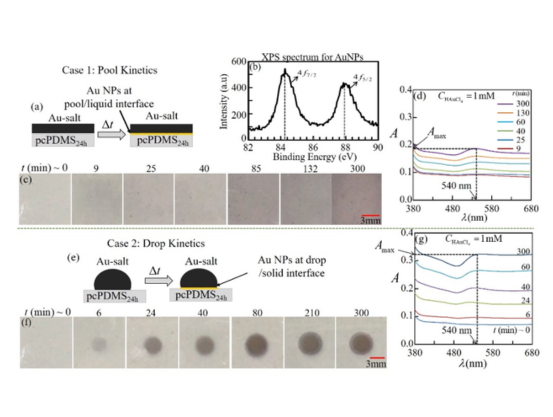
Abstract:Electrified sessile droplets on solid surfaces are ubiquitous in nature as well as several practical applications. Although the influence of electric field on pinned sessile droplets and soap bubbles have been investigated experimentally, the theoretical understanding of the stability limit of generic droplets remains largely elusive. By conducting a theoretical analysis in the framework of lubrication approximation, we show that the stability limit of a sessile droplet on a lyophilic substrate in the presence of an electric field exhibits a universal power-law scaling behaviour. The power-law exponent between the critical electric field and the droplet volume is found to be -1. The existence of this scaling law is further explained by virtue of minimization of the total free energy of the electrified droplet.
Read More ...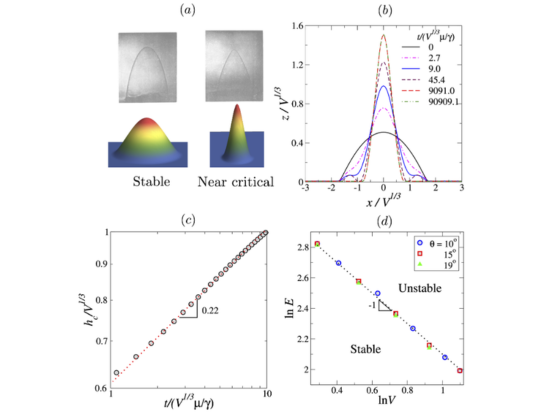
Abstract:
Background: The severe acute respiratory syndrome coronavirus 2 (SARS-CoV-2) has caused the coronavirus disease 2019 (COVID-19), which is associated with cardiovascular problems and serious lung damage. COVID-19 patients with comorbid conditions are at a significantly elevated risk of increased morbidity and mortality. Angiotensin-converting enzyme 2 (ACE2) and transmembrane protease serine 2 (TMPRSS2) are the two key host contributing factors for the severity and pathogenesis of COVID-19. The principal SARS-CoV-2 entrance receptor, ACE2, is expressed equally in most organs and produces cardio-protective vasodilators by physically degrading angiotensin II, the main controller of the Renin-Angiotensin Aldosterone System. However, treatment for cardiovascular disease (CVD) commonly involves RAAS inhibitors, which may increase ACE2 expression. Objective: To summarize the pharmacological molecular discoveries into the processes of viral infection and its consequences for cardiovascular disease and to offer suggestions for the practical management and treatment of COVID-19-related cardiovascular injury. Methods: This review focuses on the important considerations related to the cardiovascular manifestations of COVID-19 and discusses the various mechanisms of COVID-19 that contribute to its molecular and pharmacological presentation of cardiovascular injury. Results: The host-pathogen relationship began with ACE2’s attachment to the S-protein and proceeded with TMPRSS2’s proteolytic cleavage of the viral spike (S)-protein and ACE2. Currently discovered protein-protein interactions explain the uniqueness of SARS-CoV-2 infection. Conclusion: COVID-19 is associated with cardiovascular problems and serious lung damage. ACE2 and TMPRSS2 are key host contributing factors for the severity and pathogenesis of COVID-19. The molecular discoveries into the processes of viral infection and its consequences for cardiovascular disease provide important considerations for the management and treatment of COVID-19-related cardiovascular injury.
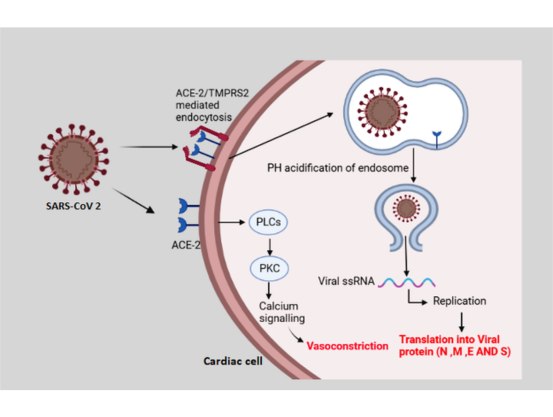
Abstract:
The algae biorefinery ideas have getting lot of attention recently. The newly emerging algae mediated bioeconomy takes precedence to characterizing and tackling significant improvements in biomass, biofuel and bioproducts productivity. Such emerging advancements must be guided by financial and sustainable development fundamentals, which will aid in unravelling the controversial bioproducts-energy-ecosystems interconnection something which algae reside. Acknowledging the metabolic processes of algae's storage energy metabolism to generate bio - fuels as well as bioproducts can shed light on the crucial obstacles which currently limit net carbon utilization and photosynthesis potential, inevitably guiding production efficiency as well as economic potential in the face of limited assets. We reveal numerous possible mechanisms for a theoretical algae biorefinery structure in this analysis, for each item (biofuel and bioproducts) addressing a specific major challenge identified to better future. Researchers connect each promising bioproduct, characterise appropriate conversion and extraction mechanisms, and explain market potential with values related to product commercialization.
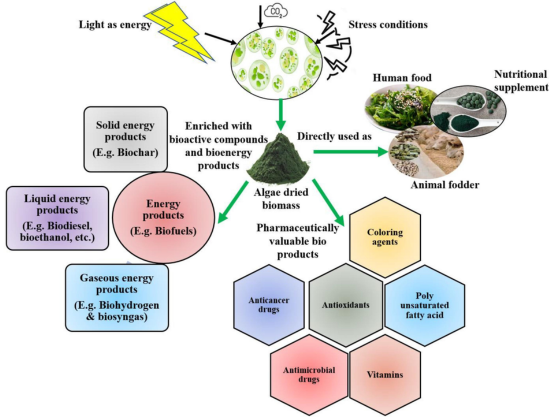
Abstract:
This study presents a novel hybrid approach combining heterogeneous catalytic chemical reaction with biological intervention to denitrify wastewater. A graphitic carbon nitride (g-C3N4)-supported Ni-carbon nanofiber (CNF) is used as the catalyst, while Achromobacter denitirificans, isolated from an effluent of a sewage treatment plant, is used as the denitrifying bacteria. g-C3N4 acts as an artificial electron elicitor for biological regulation. Ni enhances the activity of key enzymes which are involved in bacterial denitrification, while the CNF surface immobilizes the bacteria. The catalyst and bacterial cells are characterized and identified using spectroscopic techniques and 16S rRNA sequencing, respectively. The data reveal approximately 99% removal of nitrates from water in 24h at the nitrate concentration of 150 mg/L at the catalyst and bacterial dose of 0.025 g/L and 1% (v/v) with 107 CFU/mL, respectively. Spent water can be recycled and reused. This study provides a new strategy for the denitrification of wastewater.
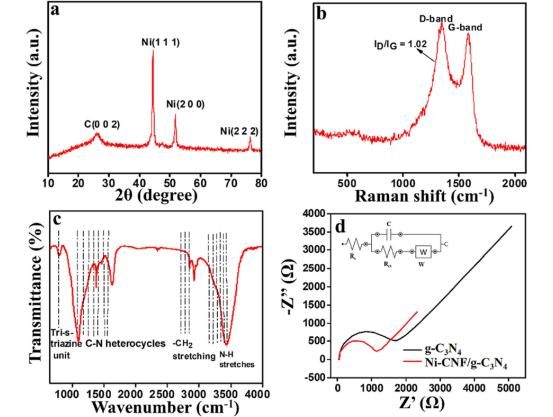
Abstract:
The prompt asserts that identifying low levels of vitamin D (hypovitaminosis D) in pregnant women and infants at an early stage is crucial due to the irreversible clinical consequences that can result. The measurement of 25-hydroxy Vitamin D3 levels can serve as a valuable indicator of the risk of developing Vitamin D deficiency. Graphene, a two-dimensional material composed of sp2 hybridized carbon atoms, is highly regarded due to its exceptional thermal, electronic, optical and mechanical properties, as well as its single-atom thickness and large surface area. In this investigation, graphene oxide (GO) were incorporated into paper electrodes, creating a cost-effective material that served as a matrix for developing an immunosensor. Using modified Hummer’s method, graphene oxide was synthesized and subsequently drop-cast onto the surface of a screen-printed paper electrode (SPPE), resulting in enhanced electrochemical signal. Thereafter, SPPE was modified with graphene oxide (GO) and further functionalized with 25-hydroxy Vitamin D3 monoclonal antibody using cross-linking chemistry of EDC:NHS. To characterize the synthesized GO, various analytical techniques were employed, including UV–Vis, FT-IR, Particle Size Analyser, Raman analysis, FE-SEM, TEM and XRD analyses. The stratified modification of the electrode surface was monitored through FT-IR and EIS techniques. Finally, the sensor response was measured after hybridization with different antigen concentrations by CV and DPV analyses. For electrochemical measurements, “K3[Fe (CN)6]3-/4- (5 mM in PBS buffer, pH 7.2)” was utilized as a redox indicator. The developed smart phone android based immunosensor showed a sensitivity of 2036.12µA/mm2/fg and LOD 5.96 fg/µL for electrochemical detection of vitamin D3.
